#James Portelli
Video
youtube
« JUST LIKE EMMA » ON 242 RADIO UK -- ENGLISH
"Just Like Emma" Sur 242 RADIO UK
will be broadcasted every 2 weeks at the following times;
"Just Like Emma" Sur 242 RADIO UK
sera diffusée pendant 2 semaines aux heures suivantes;
Monday -Lundi
16h 00 UK/17h 00 France / 11h 00 EAST COAST/ 07h00 PST
Tuesday- Mardi
22h 00PST Wednesday -Mercredi
06h 00 UK/ 07h 00 France/ 01h 00 EAST COAST
Thursday - Jeudi 19h00 EAST COAST /16h 00 PST
Friday - Vendredi
00h 00 UK/ 01h 00 FRANCE
SHOW N° 64 – « JUST LIKE EMMA » ON 242 RADIO UK
1- OF THE SUN AND THE MOON « DESPERADO »
2 - ARNOLD TURBOUST « RUE DE LA CROIX NIVERT »
3 - CHARLOTTE COULAUD « J’AI UN SOLEIL »
4 - BéESAU « CHAMBRE AVEC VUE »
5 - JEAN-CHARLES PAPI « SPERA »
6 - OLIVIER AVEN « TELL ME WHAT YOU SEE »
7- CHECCA « SUIS TON CHEMIN »
8 - MONOTRONIC « WHEN YOU DREAM »
9 - ERIK SKAR BAROUX « COMME SI C’ETAIT »
10 - JAMES LYNAS « I’LL NEVER NEED ANYMORE THAN THIS »
11 – LES HYENES « ICI-BAS »
12 – STEPHANE PORTELLI « LA BOUTIQUE DES FOUS »
13 – KRIS OFWOOD « THINGS THAT I DO »
14 – KORETTA « TROP BEAU »
15 – GENERIQUE « I LOVE YOU THE WAY YOU ARE » EMMA GOLDBERG
https://www.youtube.com/watch?v=YNlo4OdEvj8
0 notes
Text
MACHINATION trailer released
Breathe In Fear …
Psychological horror at its finest this May with MACHINATION from directors Sarah Jayne Portelli and Ivan Malekin.
Starring Steffi Thake, Rambert Attard, Sean James Sutton, and Andrew Bonnello, MACHINATION is an entirely improvised film about a young woman forced to confront the monsters that haunt her. News of an out of control pandemic has gripped the world and mass panic is…

View On WordPress
#Andrew Bonnello#Ivan Malekin#MACHINATION#Rambert Attard#Sarah Jayne Portelli#Sean James Sutton#Steffi Thake
0 notes
Text
september reading
there is literally no way it is september. impossible. anyway this month we have horror, Fake Dating, the rashomon effect, a time war, and most importantly, no neutrals to be found anywhere
the old man & his sons, heðin brú (tr. from faroese by john f. west)
published on the faroe islands in 1940 and the first faroese novel to be translated into english, this is a story about the dramatic shift in life style during the 30s on the faroe islands, from hardscrabble subsistence farming/fishing to market economy. interesting look at changing life on isolated isles, and a much lighter (and shorter) take on the stubborn autonomous subsistence farmer than laxness’s independent people. 3/5
the white shroud, antanas škėma (tr from lithuanian by karla gruodis - english/claudia sinnig - german)
a modernist, fragmented, nonlinear novel about a lithuanian poet gone into exile, now working as an elevator operator in a new york hotel, who is involved with a married woman but might also be terminally ill. in between the present timeline, the book flashes back (both in the character’s own writing and in third person) to his youth in lithuania, his torture at the hands of the soviet regime, his time at a DP camp in germany and so on. quite interesting, with some great writing. 3/5
things we lost in the fire, mariana enríquez (tr. from spanish by megan mcdowell)
really good collection of horror-ish short stories that also touch on gendered violence, child abuse, poverty and argentinian history (esp. dictatorship and disappearances) - some stories are more overtly horror, with clear supernatural elements, others are more ambiguous. i don’t read (or watch) horror stuff so i’m a bad judge of how scary this is - i found it more gruesome and upsetting than terrifying, but the dread is strong in this one. favourites: adela’s house (hungry haunted house), end of term and the title story (women & self-inflictred violence), under the black water (the poisoned oil-choked river is very bad but maybe.... there’s something worse in there). good, vividly gruesome, sharp sharp sharp. 3.5/5
axiom’s end, lindsay ellis
i really like lindsay ellis, of all the ~youtube video essayists~ she’s probably my favourite and this book a) has a cool premise - aliens + conspiracies + alien communication and b) a really cool cover, and it’s lindsay, so i was super excited for this one. and it would be unfair to say i was disappointed with it; it’s a fun first contact romp with really good pacing, cool aliens, on-brand lindsay ellis humour and some interesting ideas on communicating with someone who is truly alien and incomprehensible. it’s fine! i enjoyed it and will definitely read the sequel, it’s just... i was hoping it would be AMAZING, and it just wasn’t. no huge problems (except for a few lines i would have liked to take a red pen to), just.... it was fine. 3.5/5
zeno’s conscience, italo svevo (tr. from italian by william weaver)
imagine you’re a businessman in trieste who does a little unsuccessful writing on the side and one day you decide to take english lessons to improve your business opportunities with the uk and your english teacher is JAMES FUCKING JOYCE who tells you that you need to keep writing. incredible. anyway these are the autobiographical notes of one zeno cosini, a hapless hypochondriac smug self-delusional fool, who just cannot quite quit smoking, marries the one sister out of three he least desires, & works as an accountant (for the man who married his most-desired of said sisters) despite his rather tenuous grasp on bookkeeping. my favourite scene is when his future sister in law (2nd most desired) complains lightly about her difficulties with latin, he tells her that he believes latin is a man’s language and even roman ladies probably didn’t actually speak it, only for her to correct him on a latin quotation. i will say tho that this book is way to long to maintain the endearingness and often drags. 3/5 tfw u write for an audience of one but that one is james joyce so fair enough
der hund/der tunnel/die panne, friedrich dürrenmatt
dürrenmatt (in addition to having a cool-ass name) really fucking slaps! his stuff is really good, and often really really wild. these three stories are all weird & slightly existentially scary, two degrees left of reality, and just. so interesting! we have a man stalking a street preacher and his monstrous dog, a train going through a tunnel for way too long (and it is very scary), and a man becoming involved in a pretend-trial (or is it) and becoming convinced that he actually is a murderer (or is he, really?). anyway, dürrenmatt.... slaps. 4/5
wow, no thank you., samantha irby
a mix of memoir and comedy blogpost and social critique blogpost about growing up poor & black, dating while fat, chronic illness, and settling down in rural america. it’s fine. i haven’t read irby’s previous collections so maybe i’m missing that emotional connection, but i thought it was mostly...okay?? not especially funny imo & i prefered the more serious chapters of which there weren’t enough. 2/5
they say in harlan county: an oral history, alessandro portelli
really impressive oral history about life in harlan county, appalachia, focusing on the labor strikes and conflicts in the 30s and 40s, but really exploring life and politics in the region from the first non-native settlement there to today. really interesting, sometimes inspiring and often infuriating and probably worth reading if you’ve ever listened to which side are you on. 4/5
rashomon & other stories, ryunosuke akutagawa (tr. from japanese by jay rubin)
fun fact: if you read the short story “rashomon” expecting to get the, y’know, rashomon effect, you won’t get it bc the film actually takes its plot from the story “in a grove”. anyway this is an interesting collection of classic japanese short stories, many of which are actually about unreliable witnesses/narrators. i particularly enjoyed “in a grove” and the truly disturbing “hell screen”, but found this particular collection just a bit too long. 3/5
women without men, shahrnush parsipur (tr. from farsi by kamran talatoff & joceyln sharlet)
a magical realist feminist novella about 5 women in iran who all try to liberate themselves from men in one way or another, more or less successfully (one of them turns into a tree, another becomes undead), until they end up in a semi-utopian garden together for a time. disturbing in its depiction oppression and sexual/gendered violence. i don’t really know how i feel about it, but it’s a really unique and interesting reading experience; very fraught and ambivalent in the end. 3.5/5
take a hint, dani brown, talia hibbert
i think this is the first actual pure genre-romance book i’ve read... in years??possibly ever? idk. anyway this is mostly a pretty fun & sweet story about ambitious & emotionally constipated phd student dani brown and security guy with tragic past zaf ansari, who begin a fake relationship for Various Reasons (as you do) and both develop Real Feelings (as you do, predictably). it’s mostly really enjoyable but man i’m really not used to Romance writing & it’s a lot. in the end everyone is very genuine & earnest & emotionally honest which.... not to be even more emotionally repressed than dani but i cannot deal with that. anyway given that 2020 truly is the gift that keeps on giving this was a fun fluffy delight & i might read more from the series. 3.5/5
this is how you lose the time war, amal el-mohtar & max gladstone
two agents (red and blue) on opposing sides of a time war (the futuristic techy Agency vs the eco/organic Garden - neither of them is Good or Bad exactly) start writing letters as they hunt each other through the strands of time’s braid and eventually (inevitably) fall in love. really interesting concept of time travel and different timelines (if, like me, you conceptualise past as down and future as up, this will trip you up so much), very lyrical writing that sometimes toes the line to overwritten but mostly really works. 3.5/5
DNF: the madman of freedom square & the iraqi christ, hassan blasim (tr. from arabic by jonathan wright, german tr. by hartmut fähndrich)
bindup of these two short story collections about iraq. these are incredibly brutal, depressing & horrifying stories about a country in a constant state of war & struggle. couldn’t bear it, probably not ever & certainly not right now.
allegro pastell, leif randt (audio)
this is brilliant, bitingly funny novel about a millenial couple, tanja & jerome, and their on-and-off long distance relationship. they are privileged (and half-aware of it), attractive, successful, very in touch with their own feelings (couldn’t be me), self-reflective, faintly ironic in everything bc sincerity might be cringe, and you will hate them. these are people who perform their feelings rather than feel them, dissect all their opinions and impulses to the point of both paralysis and narcissism, engage in constant navelgazing and cannot form any relationship that isn’t based in constant evaluation and judgment. they pride themselves on their nonconformity but are really the greatest conformists of all, and the most square, boring, spießig people under the veneer of their urban liberal drug-and-club lifestyle. had so much fun with it even as i was constantly cringing at these people. 4/5
1 note
·
View note
Text
Below is an interview with Marie Louise Muscat Azzopardi, a pilgrim who walked the European Peace Walk (EWP) in 2017, and friend of guest blogger James Portelli.
Pilgrim Interview: European Peace Walk
By James Portelli
Meeting Marie Louise
Marie Louise
Have you ever crossed paths with someone who strikes you as a breath of fresh air, a person brimming with positive energy? My wife Tucc and I have known such a person—Marie Louise—for a few years now and we always look forward to meeting her on treks we join. I recently met with Marie Louise to discuss her most recent trek, the European Peace Walk.
A mother of three and a grandmother of two, Marie Louise is a Camino aficionado and a member of the Ramblers’ Association of Malta, a walking group she joined in 2005. She is often the go-to person for scouting a local trek. But since her retirement from teaching English and French three years ago, Marie Louise has taken a more active role in the Ramblers’ Association not only in Malta but also throughout Europe. She is now responsible for the association’s annual walking calendar, which includes over seventy different walks per year—some of which she leads—and she helps organize walking trips abroad, the latest starting from Sweden (Eurorando Trekking Week) and from Spain (Catalonia Trek Festival).
I ask Marie Louise what draws her to long-distance walking. She explains, “A knee injury more than a decade ago made me give up triathlons. Long-distance walking provided me with the freedom to experience new places and people and establish a rhythm of walking in constantly changing landscapes that helped me to de-stress and to unclutter my mind. Meeting people—young and old—from all walks of life is so invigorating.”
In 2008 Marie Louise completed her first Camino (Camino Francés), walking over thirty-two days from St. Jean Pied de Port to Santiago. This Camino for her was a solo experience and, in many respects, a character building and personal development process from which she emerged enriched. Marie Louise reflects.
“The overall experience also strengthened my faith in divine Providence. My personal experience is this: God provides what you need when you need it and sometimes when you least expect it.”
Various episodes and numerous people on the Camino Francés helped strengthen this conviction. After Marie Louise’s first Camino, there was no turning back. She asked herself, “Now, what next?” What followed was a series of Caminos.
In 2009 Marie Louise walked over 750 km from Le Puy, across the Massif Central, to Roncesvalles in Spain. She followed this trek with the Camino Primitivo. Next she embarked on a three-week trek covering part of the Arles route in France, starting in Toulouse and then linking up with the Camino Piemontese, stopping at the monastery at Tarasteix, and then on to Lourdes before crossing the Pyrenees on the Somport Pass. From there she joined the Camino Aragonés, finishing at Puente la Reina. Marie Louise’s last Camino route experience was the Norte, starting from Irun/San Sebastián and finishing in Oviedo.
The European Peace Walk
Marie Louise first heard of the European Peace Walk (EPW) through Facebook. Although similar to the Camino in many respects, the walk’s newness drew her to it initially.
The EPW is still in its infancy. “The 2017 European Peace Walk,” explains Marie Louise, “was the fourth since it was first launched, so I feel like I am one of the pioneers trailblazing this route.”
The EPW is around 570 km long starting in Sopron, Hungary, (an hour’s train ride from Vienna) passing through Hungary, Croatia and Slovenia, and finishing in Trieste, Italy. The walk follows more or less the front line of the First World War and borders segments of the Iron Curtain.
Iron Curtain Trail
“It is a very sobering experience walking beneath the now abandoned but still standing sentry towers,” explains Marie Louise.
What distinguishes EPW from the Camino Francés or other Caminos?
I ask Marie Louise what distinguishes the EPW from the Caminos and, as a veteran Camino walker, how she adapted to the differences.
Similar to the average Camino, the EPW takes approximately three weeks to cover, and just like on the Caminos, the walk fosters camaraderie and new friendships. What’s very different is the EPW registration requirement.
Registration is required and necessary because accommodations on the EPW are still relatively limited. A daily limit of ten walkers starting the EPW ensures that there are enough beds at every stage. To a great extent, this limit also regulates the daily tempo because walkers have to cover a fixed amount of kilometers per day to reach the next accommodations. Distances vary roughly between 25 km and 35 km per day.
Not surprising, a registration process necessitates a registration fee. Although nominal at € 50 ($60 approx.), the registration fee is more than a Camino credential. But there are benefits to being registered that one does not enjoy on the traditional Caminos. For example, it is easier to monitor the number of walkers per stage and—in case of emergency or distress—it is beneficial that one is already known to EPW organizers.
Another notable difference from most Camino routes (and one walkers must especially plan for) is cafés and restaurants are few and far between on most stages of the EPW.
Also, unlike the Camino routes, the EPW is not open all year round. For example, in 2017 the trail is open from May to September. In early May two organizers walk the trail refreshing the red paint on the arrows and fixing the red stickers that act as waymarks. And although the route is very well marked, because the terrain and landscape constantly change, walkers must be very careful to not miss a turn. Unlike the Camino, EPW is not a beaten trek, so one wrong turn can cost additional hours of walking.
Finally, although there is a possibility of shortening the walk by either taking a bus or taxi, one cannot just stop halfway through a day’s walk and decide to spend the night in a different albergue (hostel) as one does on the Camino. Accommodations are pre-planned and, therefore, the number of walkers starting per day is pre-planned. For better or for worse, one tends to walk with the ten persons with whom one started the EPW. However, this does not preclude walkers from adopting their own pace.
Marie Louise recalls from her earlier Caminos, “I was accustomed to and preferred waking up early, setting off at or before sunrise and walking briskly during the cooler morning hours.” She tells me she continued this practice on the EPW, then explains, “Others left later and then either our paths would cross in the afternoon or we would meet at the next accommodation in the evening where we would not only share dinner but also the day’s experience—not unlike what one would do on the Camino.”
Lake en-route
So with all its differences from the Caminos, how did Marie Louise feel about starting the EPW and walking with the same group of people?
“I invariably find the first couple of days of any long-distance walk relatively awkward. Have I packed too much? Have I packed too little? Can I manage the backpack for 25 to 30 km on a very warm day? Will I have to endure blisters? Will I be allowed to walk solo or will I have to walk at someone else’s pace making polite conversation?” But she admits, “The process grows on you and after a few days it is surprising how we bonded despite the various nationalities, backgrounds, or characters. Albert Einstein’s adage ‘Peace cannot be kept by force; it can only be achieved by understanding’ would perhaps be a befitting motto for the Peace Walk. In this respect, EPW is not dissimilar to the Camino in the spirit of camaraderie that it fosters.”
Marie Louise started the EPW on June 3, arriving in Trieste on June 21. In early June walkers endured a heat wave that hit Europe, and Marie Louise’s group was impacted. The heat wave incentivized her to start walking earlier each day. “I used to wake up at 4:30 a.m. and start walking by 5:15 a.m. in order to avoid prolonged walks in intense heat and sunshine. This meant that I savored a sunrise en route every day. Later on in the day, as the sun started beating down on us it became more a matter of mind over body. With six to eight hours of walking per day, I generally reached the next destination by early afternoon.”
But, of course, one major plus of long-distance walking, even for those who, like Marie Louise, prefer to walk solo, is the new friendships one strikes while trekking. Marie wasn’t the only one waking up early to avoid the heat. “I hit it off with a lovely Canadian couple who, like me, were early risers. We used to slip out of the house at sunrise, walk a short way together, then separate and walk at our own pace, meeting again as the day wore on. There were segments of the trek that were relatively deserted. Consequently, having some company or knowing that I am not far behind or ahead of a familiar face proved comforting then.”
Daybreak en-route
Roadside Shrine
What were the longest and shortest walking days on the EPW?
I ask Marie Louise to recall her longest and shortest walking days on the EPW.
“The longest day was from Bistra to Postojna. Although the guide book said 33 km, I walked for around 36 km because of a wrong turn that I took earlier on during the day. I walked for nine hours that day.
“The shortest walking day was just 18 km from Ocizla in Slovenia to Trieste in Italy. This being our last segment, all seven from the original ten (three had stopped earlier for various reasons) walked together. The pace was also more relaxed on this last day as we enjoyed every remaining moment knowing that we would soon be reaching our destination.”
Which EPW experiences stayed with Marie Louise?
On any walk some experiences are more memorable than others. Marie Louise tells me which ones stayed with her.
“The group consisted of a recently retired Canadian couple, an Australian couple, two Irish friends, and three ladies from Isle of Man, United Kingdom and USA, respectively. I catch myself remembering topics we discussed along the way or during evening dinners, jokes and laughter that we shared en route or over a beer. Overall,” Marie Louise reflects, “it was a personally heartening experience.
Strawberries en-route
“Then, there were all the people we met along the way who weren’t trekkers. For example, an old white-haired woman who came out to meet us and offered us cherries and strawberries just picked from her garden. She refused any payment. There was a man whom we approached to ask for the way to a café, and he invited us to his house for coffee or a homemade lemon drink.” Marie smiles. “Then there were all the warm, friendly hosts who opened their houses to lodge us and feed us. We spent hours chatting with them and getting to know each other in an environment that was more like a home.
“I also shouldn’t forget Marlis who welcomed us with basins of cold water and salt for our poor battered feet on our arrival, and then woke up at 5:00 a.m. the next morning to prepare mushroom omelets for us to have with her freshly brewed coffee. Heaven forbid that we start the day on an empty stomach!
“It doesn’t stop there! There was Branco, a schnapps connoisseur, who demonstrated to us how he makes his own schnapps and also gave us a bottle for the road to be able to have a celebratory drink in Trieste.”
Are accommodations pre-paid on the EPW?
Marie Louise explains that, although the accommodations are booked automatically at the time of registration, one pays for accommodations at every stop. (Conveniently, most accept credit cards.) She discusses the accommodations and sleeping arrangements walkers can expect.
16th Century House
“Another attraction for me was that accommodations vary significantly from one stop to the next. We slept in yurts (tent-like dwellings), on a horse-farm, a few hostels, a massive sixteenth-century house perched on a hill, an old but well-restored cottage (complete with the Flintstones’ car in the backyard). Understandably, there was a degree of anticipation among the walkers as to what to expect at our next abode for the night. All possessed their own distinctive charm.”
Flintstone car
An average day’s accommodations and subsistence costs on the EPW are comparable to the Camino. Most of the EPW accommodations cost € 24 to € 30 (approx. $28 to $35) per night, including breakfast and dinner. And what are sleeping arrangements like?
“In some cases, we were sleeping two to a room. There were nights where I had the room to myself. Then again we also made use of small dormitories, sleeping on bunks beds. For example, once in a little village in Hungary, the local youth center transformed their town hall (which also doubled up as a small theater) into a dormitory with two lines of single beds replacing the audience seats. But even when accommodations were relatively Spartan, the level of service, in terms of cleanliness, housekeeping, and so on, was generally outstanding. I only needed to use my sleeping liner twice as on all the other nights clean sheets and pillows were provided.”
A Yurt
But when I ask Marie Louise for any advice she offers this regarding the yurts: “Ask for a duvet before you settle in for the night. The general rule is that the hotter the day has been, the colder the night would get.”
Cottage Accommodation
Are there sightseeing opportunities on the EPW? Is there an equivalent of the statue hugging ritual or the Botafumeiro (censer) once one reaches Trieste?
Marie and I wrap up our discussion, talking about the sights, the historical contexts of the Caminos and the EPW, and probably the most distinguishing difference between the two walks.
One can plan to spend an extra day in, for example, Ljubljana, or visiting Lake Bled or Zagreb while on the EPW. However, this very much depends on whether one wishes to “break” the tranquility of mainly countryside walks, since cities always bring with them some crowds and chaos, particularly during the summer months—bearing in mind that central Europe is a popular summer tourist destination. Notwithstanding this, an extra day in Trieste at the end of the walk is highly recommended. In fact, upon reaching Trieste, it has become something of a tradition to take a photo in Piazza Unità d’Italia with the backdrop of the Palazzo del Municipio or the Adriatic Sea.
One would not expect to find a cathedral or religious ceremony at the end of the EPW because its rationale differs from the Camino: the EPW does not have a legacy of Christian and medieval history. (Perhaps this best explains the absence of the hugging of the statue, a religious service or the Botafumeira.) Instead, the EPW emanates from a relatively more recent and more turbulent history: the wars that ravaged Europe in the twentieth century.
The open borders enjoyed in Europe today are the result of the freedom of movement fostered by the European Union (EU). The precursor of the European Union was the European Economic Community (EEC) established by the 1957 Treaty of Rome, just a few years after the death of Stalin and at the height of the Cold War. Not only has the European Union succeeded in ending wars between major powers in Europe but it has also prevailed over the Cold War and unified more countries into one region. The Camino de Santiago de Compostela benefitted greatly from EU initiatives (particularly those from the 1980s to the present) because it was also seen as a unifying force for good within Europe with Caminos from as far afield as Poland.
The EPW is symptomatic of this unifying ethos and Trieste (once part of the Habsburg monarchy and and, at one time, an influential Austro-Hungarian city and seaport) strongly resonates (even now) three different cultures: Italian, Austrian, and Slovenian. In addition to its rich heritage, Trieste had also its dark moments. A testament to one of these moments is the Risiero (old rice mill), which was converted to a concentration camp during World War II. All of these influences, plus the Cathedral of San Giusto, the Jewish Quarter, the Miramare Castle, the Canale Grande, the James Joyce and Svevo Museums, the Trebiciano Abyss, and the Grotta Gigante, add to the magnificent chiaroscuro masterpiece that is Trieste.
Piazza Unita Trieste
“Reaching Trieste is not like reaching Santiago!” confirms Marie Louise, “but the significance of the European Peace Walk—not unlike life—is not in the destination but in the journey.
“Upon reaching the main square in Trieste, we hugged, took some photos, and—of course—shared the schnapps supplied earlier by Branco. After that, the Adriatic Sea beckoned and we followed. It was a refreshing end to a spectacular three-week experience.
“The EPW lacks the credential concept because the hosts at every accommodation are already expecting you. But this also means that there is no “Welcome Desk” at the end of the EPW similar to the Pilgrims’ Office where all the peregrinos (pilgrims) congregate to collect their Compostela. This will perhaps come as the EPW grows. Admittedly, the stamped credential and the Compostela are mementos that one tends to treasure following a Camino experience. A similar concept, if introduced on the EPW, would also serve the same purpose.”
Marie Louise highly recommends the EPW to peregrinos because of its authenticity. It is not yet commercialized, and locals still stop walkers to ask where they are walking and why. “It is as if,” Marie Louise thinks, “both hosts and travelers are still discovering and enriching the whole experience.”
James Portelli
James Portelli is an occasional guest author on this blog who wrote route reports about his experience on the Camino Inglés in 2016. Read more of James’s posts:
Santiago to Finisterre
Montserrat, A Day to Remember
La Sagrada Familia in Barcelona
Life Is a Journey: Siezenheim to Santiago
Love Your Neighbor as Yourself
Loving Myself
The Here and Now
Camino Baltica
Pilgrim Interview: European Peace Walk #EuropeanPeaceWalk #EPW #IronCurtainTrail #PeaceWalk #Camino Below is an interview with Marie Louise Muscat Azzopardi, a pilgrim who walked the European Peace Walk (EWP) in 2017, and friend of guest blogger James Portelli.
0 notes
Text
Everything You Need To Know About Working With A Builder
Everything You Need To Know About Working With A Builder
Building Better
by Amelia Barnes
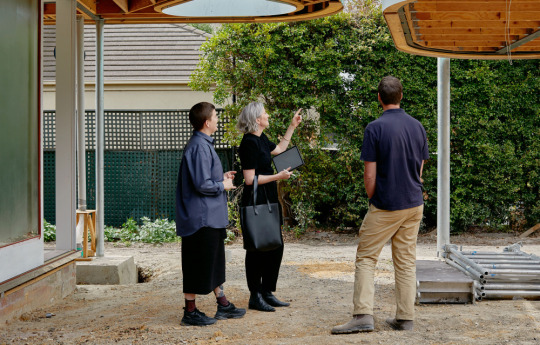
Monique Woodward from Wowowa on site with Basis Builders. Photo – Amelia Stanwix
How do I find a great builder for my home?
The best ways to find a builder are by asking friends, neighbours, architects or real estate agents for recommendations, or observing the work sites of nearby projects.
‘A drive around your local area looking for building sites that are neat, have nice signage, and a tidy nature strip out front is a good start. It’s not a sure sign of a good builder, but if they care enough about their site’s presentation, then surely that’s a good indication of how they manage their business,’ says Rhys Vleugel, director of Basis Builders.
You can also ask to speak to some of the builder’s previous clients for a direct testimonial.
‘If a builder is unable to get you to walk through a past project or speak to a past client, then that is not a great sign!’ says James Gooley, director of Visioneer Builders.
The next step is interviewing multiple builders to ensure your values and expectations for the project align. For example, if you’re hoping to have the entire project wrapped up by Christmas, mention this upfront!
James also recommends asking whether the builder has completed projects of similar scale and complexity before and whether there will be a full-time site manager or one managing multiple projects at once.
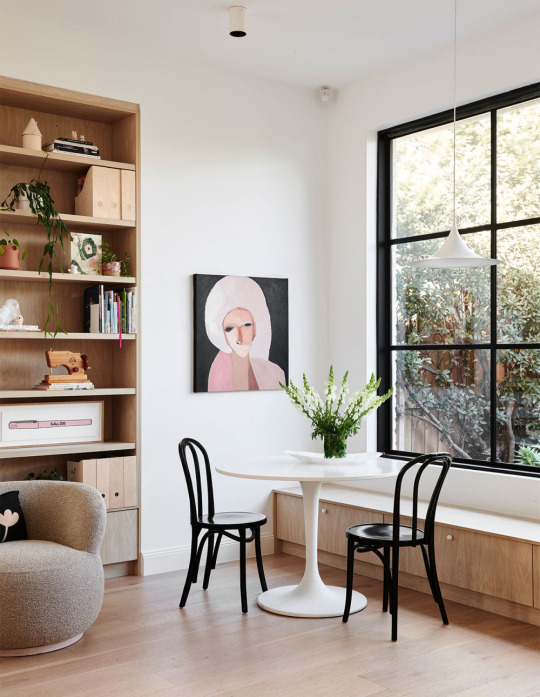
The home renovation of BuildHer Collective member Maddie Witter, constructed by Calibre Built Developments. Photo – Eve Wilson for The Design Files. Styling – Annie Portelli

BuildHer Collective member Maddie Witter designed the floor plan of her home renovation after completing a BuildHer Collective course. She then worked collaboratively with Calibre Built Developments to bring it to life. Photo – Eve Wilson for The Design Files. Styling – Annie Portelli
At what point of a residential project should I contact a builder?
When exactly you should start contacting prospective builders slightly depends on who is involved in the project. For example, if you’re looking to complete a relatively simple bathroom renovation, a builder may be the first and only design/construction professional you contact.
‘Traditionally after your plans are complete, you might have an initial consultation with a builder to discuss the project, and then provide the documentation for them to tender on,’ explains Rebeka Morgan, director of BuildHer Collective. ‘However, there are many ways of running projects, and we are seeing more of our clients looking to value manage their project by getting builders in on the design phase, to both ratify costs and suggest some cost management to the structural works.’
In the case of BuildHer Collective member Maddie Witter, she started working directly with a builder immediately upon purchasing the home she planned to renovate, alongside Co.Kitchens in the initial phase to design her kitchen.
‘When I purchased the home, I put it as part of my settlement to be able to visit the site three or four times before closing, so that the builder could actually start giving me advice, and we could start building that floor plan,’ Maddie says.
For residential projects where an architect is involved, a builder will usually come on board soon after the very initial design plan.
‘Having the builder on board during the first steps opens the doors to early engagement with subcontractors allowing us to take advantage of their specialised knowledge,’ explains James. ‘Crucially, it also allows for realistic conversations around the build time and budget.’
Never Stop Group director Damien Collins says contacting a builder at this early project stage allows for a high-level price estimate and clear discussion about the overall intent.
‘A practical starting point is to send them over to their local Reece showroom to browse through their options for fixtures and fittings,’ Damien says. ‘This gives us an idea of whether they are looking for the top-of-the-line tapware, or just something simple, functional and high quality.’

The renovated home of Jess Dempsey. Photo – Eve Wilson. Interior design + styling – Cassandra Walker. Photo styling – Annie Portelli
Will a builder also help to design my house?
The answer to this question again depends on what parties are involved in the project. If you are working with an architect or other designer, a builder will likely only provide advice on construction methods or materials, but won’t be heavily involved in determining the aesthetics of your home.
If however you are working directly with a builder only, your builder may be more hands on in determining the best layout, materials and fittings for your home.
‘If you are working from less detailed documents, or you are running the design and selection of finishes alongside the build, you might work closely with the builder to resolve details,’ explains Rebeka.
A good builder will also identify any potential issues in the initial plan, and understand the design intent of the project.
‘As detailed as the architectural packages generally are, not everything can be completely drawn. It’s important that a builder does not make design decisions without consultation, but they definitely have a role to play in the “buildability” of these details,’ says Rhys.
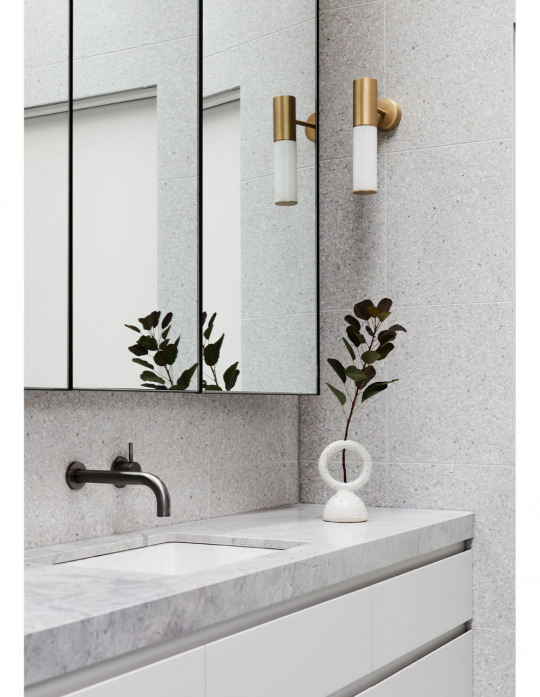
Jess Dempsey’s Armadale home. Axa Sink 50 Undercounter Glaze Basin, Sussex Scala Bath/Shower Mixer in Brushed Gunmetal, Sussex Scala Curved Wall Outlet in Brushed Gunmetal. All products by Reece. Photo – Eve Wilson. Interior design + styling – Cassandra Walker. Photo styling – Annie Portelli
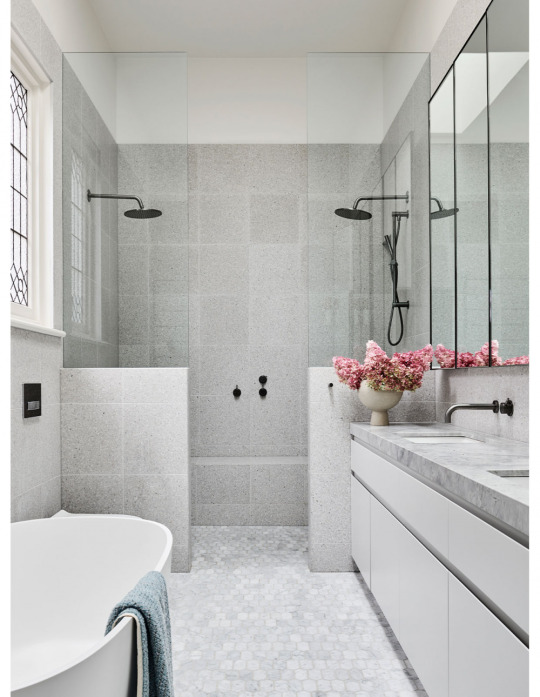
Jess Dempsey’s Armadale home. Kado Lussi Freestanding Cast Solid Surface Bath, Axa Sink 50 Undercounter Glaze Basin, Sussex Scala Bath/Shower Mixer in Brushed Gunmetal, Sussex Scala Curved Wall Outlet in Brushed Gunmetal, Milli Pure Shower Head in Brushed Gunmetal, Milli Pure Horizontal Shower Arm in Brushed Gunmetal and Geberit Sigma 50 Dual Flush Button in Gunmetal. All products by Reece. Photo – Eve Wilson. Interior design + styling – Cassandra Walker. Photo styling – Annie Portelli
What is involved in a building contract?
A building contract outlines exactly what a client can expect on a project, including costs, timelines, and how variations and delays from both sides will be handled.
‘Building contracts are in place to clearly outline what is “in” the scope, and therefore what is “out”’, explains Rhys. ‘They protect the client in a sense that the builder is legally obliged to deliver everything that is in the contract documents (such as plans, details and specifications). They form a “line in the sand” cost wise, as often variations arise (client driven or latent conditions) that were clearly not allowed for in the contract set of documents.’
James offers additional advice. ‘Always ensure you have a completion date in your contract and a rate for “liquidated damages” should the builder not finish the build by the contracted end date. Try to not have many “special conditions” and if there are any, ensure you have a legal representative review the proposed conditions prior to agreeing.’
Most importantly, James says, ‘If your builder is telling you that you don’t need a building contract, then you are speaking to the wrong builder!’
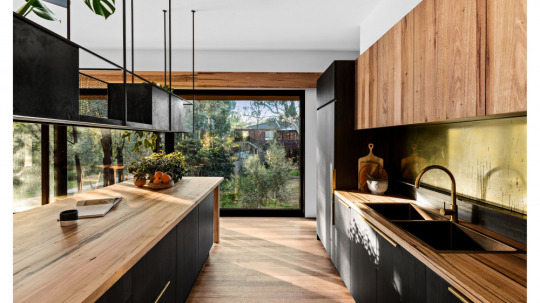
Edgars Creek House by Breathe Architecture. Builder – Never Stop Group. Photo – Joel Noon
How are builders’ fees calculated?
Pricing your project involves obtaining fee proposals from professionals for services, or sourcing estimates, quotes or tenders from builders or tradespeople for labour and materials.
Tender documentation is a specialised set of drawings and specifications that enable any builder to price your project. As a client, this allows you to easily compare costs between multiple builders.
Alternatively, you may prefer to finalise the details with the trades as you build. The more information you supply, the easier it is for a builder to price reliably, leaving you less open to financial risk.
Fees are structured differently from builder to builder, and are sometimes presented as a lump sum, or a percentage of the total construction cost.
‘Fees, or margin, are calculated as a percentage of the total build cost, typically between 10-15%. This fluctuates slightly depending on the project, considering risk and the size of project,’ says Rhys for Basis Builders projects.
Damien says Never Stop Group’s overhead and operating costs account for 7% of their fees, with 3% profit on top, amounting to a flat 10% percentage fee (i.e 10% of the total construction cost). Beyond this, the company provides a detailed ‘trade breakdown’ that details separate costs such as carpentry, plastering, plumbing, painting and electric.
Total construction costs vary significantly. Of the builders spoken to in this story, the total construction cost of projects ranged between $80,000 (for a small extension), up to $10 million+!
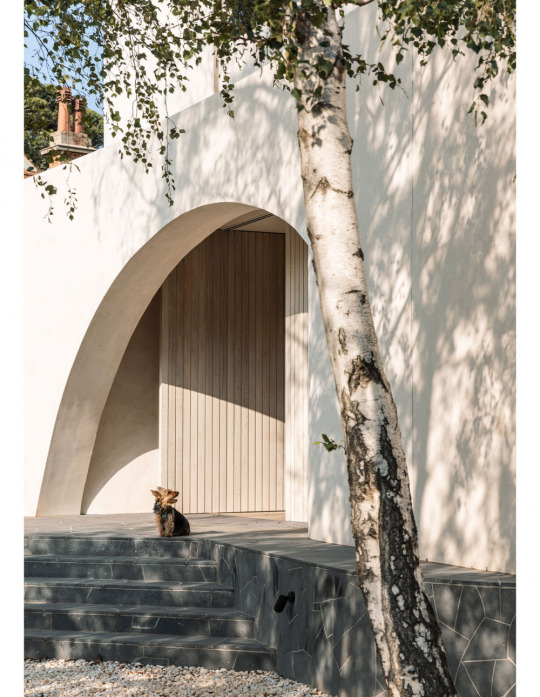
Birch Tree House by Susi Leeton Architects. Builder – Visioneer Builders. Photo – Felix Mooneeram

Monique Woodward from Wowowa working alongside Basis Builders on a residential site. Photo – Amelia Stanwix
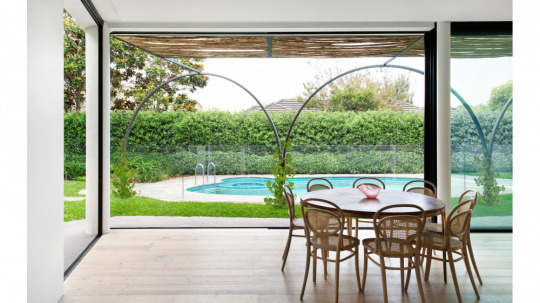
Birch Tree House by Susi Leeton Architects. Builder – Visioneer Builders. Photo – Nicole England
How long will construction take?
The length of the construction period is obviously dependent on how large and complex your project is, but also how often your builders are on site.
Damien advises establishing these facts upfront. ‘Ask them about their company structure: what support do they have in the office? Who will be on site each day to manage the quality of the work? Do their projects operate daily or will it be done in spurts, with lulls in activity on site over time? We often pass by sites which sit idle for weeks and months at a time and we wonder what the poor clients must be thinking.’
The number of employees within the company will also impact how quickly projects can be completed.
Visioneer has 34 employees and three directors, which allows them to build between 12 to 15 projects at the same time. Each project has a minimum duration of around 12 months, but can be up to 36+ months for larger projects.
Basis Builders’ average construction time frame is 14 months and they run four projects concurrently.
Never Stop Group usually have 8 to 12 projects being built at once (with the same amount in the tendering and design development phase), and their average build-time is around seven to eight months.
‘As a rule of thumb, most of our projects take about one month per $100,000 of value. Therefore a $700,000 project would be about seven months, whilst a $1 million project needs around 10 months,’ says Damien. ‘A good builder will communicate with you honestly and provide you with a detailed timeline based on your specific project.’
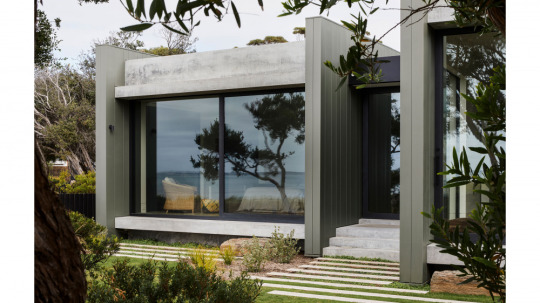
Balnarring Beach House by B.E Architecture. Builder – Basis Builders. Interior design – Anouche Design. Photo – Tatjana Plitt
How can I avoid budget blowouts and other issues?
We’ve all heard nightmare stories about house builds gone wrong, but these can always be overcome with the right team, mindset, and communication.
The best advice for avoiding budget blowouts is to lock in material and product specifications before building.
‘Don’t change things once the project has commenced! There is a misconception that builders love variations, whereas I can assure you, Visioneer do not!’ says James.
Damien also recommends a cost contingency of around 5% of the total build cost. He finds only 1-2% is usually required due to existing conditions, with the remainder spent by the client on upgrades. In other words – without contingency, budget blowouts often occur because you’ve selected something additional (fancy tiles/kitchen bench/floor coverings/whatever!) along the way that is out of scope, or more expensive that initially specified in the building contract.
Last by not least, trust your builder. Damien says, ‘At times, a project in progress may not look the way you had dreamed it would, and you may second guess the plans. Try and step back to allow the whole process to come together!’
Reece helps turn one day delaying into day one of your building or bathroom renovation journey. Discover the work of local builders from across Australia on Reece’s Project Inspiration Gallery.
1 note
·
View note
Text
“Il primo passo è stato la Luna, Marte sarà il secondo, ma dobbiamo arrivare in un altro sistema solare”: dialogo con Alfred Worden, il pilota dell’Apollo 15
C’è uno spicchio di luna, stasera, che squarcia l’oscurità del cielo sgombro da nubi. Chissà cosa si prova a guardarla da vicino, ad atterrarci sopra. Quando vedo, per la prima volta, Alfred Worden, in una sala ovale immersa dentro un edificio solitario sulla collina, a pochi passi da un cimitero puntellato dal rosso dei lumini (siamo ad Induno Olona, nel varesotto, la sala è un centro polivalente per anziani, Asfarm, l’evento organizzato da Asimof, l’Associazione Italiana Modelli Fedeli dell’esplorazione spaziale, l’intervista curata da Paolo Attivissimo, un giornalista e traduttore esperto in materia scientifica), dice che sta digerendo il gelato (“uno dei gelati più buoni della sua vita”).
*
Quelli dell’Apollo 15: David Scott, Alfred Worden, James Irwin. Era il 1971
Il colonnello Alfred Worden, pilota del modulo di comando dell’Apollo 15 e il primo uomo ad effettuare un’attività extraveicolare nello spazio profondo non è certo un ragazzino, ha 87 anni, pur svelando l’ombra di un’antica bellezza, il suo volto è segnato dal tempo che è passato da quella storica missione lunare del 1971. Sono passati solo 48 anni. Cerco di afferrare lo sguardo di Alfred, nell’illusione di poter cogliere quello stesso segreto che i suoi occhi azzurri hanno rapito così tanto tempo fa. Vedere il volto della Luna. Alfred, che dagli amici si fa chiamare Al, indossa il giubbotto leggero, tipo bomber, celeste, con lo stemma della Nasa e quello della sua missione, Apollo 15, sotto una polo bianca con i primi bottoni slacciati e, quando sta in piedi, si mette le mani in tasca. Il naso dritto, lievemente aquilino, le labbra serrate, anche quando si mette in posa per le foto, non sorride molto e non abbandona mai quell’atteggiamento di severo rigore che sembra accompagnarlo, mentre intorno a lui si scatenano i fotografi e una piccola folla in delirio; del resto è una star.
*
È solo uno dei diciotto uomini al mondo che ha messo piede sul nostro satellite. O meglio: il piede in realtà lui non ce l’ha mai messo, nei giorni storici dal 26 luglio al 7 agosto 1971. Mentre David Scott e James B. Irwin andavano in giro sulla Luna, sgommando su un’agile macchina elettrica (che è ancora lassù), lui era a bordo, finalmente solo, occupato a fare le sue rilevazioni e i suoi studi. Nonostante la sua apparente austerità, quando parla nel suo americano, non annoia mai e le immagini fervide che evoca si imprimono con forza nella mente, intervallate da battute ironiche, salaci, talvolta dissacranti. Vuole parlare del suo background, della vita dura in una fattoria del Michigan. “Sono cresciuto in una fattoria, allevavamo mucche, polli, anatre, avevo quattro cavalli. Fino a diciotto anni gestivo io la fattoria, fino al college. La scuola che ho frequentato era una scuola di campagna con una classe sola, formata da trenta studenti. Credo che questa sia una delle cose più belle che mi siano capitate nella vita, perché avevo la sensazione, mentre ero nelle classi inferiori di imparare di più conoscendo il programma delle altre classi, più di quanto avrei potuto imparare, in una classe di coetanei. E mi sono divertito. Ero lo studente che arrivava prima a scuola, accendevo la stufa. Poi arrivavo a casa e mungevo le mucche. A dodici anni ho cominciato a guidare i trattori e ho preso la patente di guida a quattordici anni. Ogni domenica facevamo il gelato, in casa. Crescendo in una fattoria, ho imparato presto il senso di responsabilità che è rimasto con me per tutta la vita. Ho imparato la disciplina – se non facevo io una cosa non veniva fatta – e in virtù di questa esperienza, ho deciso che non volevo trascorrere il resto della mia vita in fattoria, ma volevo allontanarmi il più possibile. Quando ero in volo non ho pensato molto a quella fattoria”.
*
Mentre scorrono le immagini sulle pareti della sala, nel silenzio attentissimo del pubblico, il colonnello Worden non lascia mai trapelare l’emozione, nemmeno quando ricorda la tragedia dell’Apollo 1 e la morte di comandante Virgil Grissom, il pilota maggiore Edward White e il pilota Roger Chaffee, i volti sorridenti nei corpi immersi nelle ingombranti e immacolate tute spaziali. I loro sguardi felici e orgogliosamente americani, a un passo dalla morte. Worden ricorda la tragedia con distacco ma anche con la consapevolezza di una catena di errori fatali. Da non ripetere. “Vorrei dire che il problema, secondo me, è stato di natura umana. Stavano facendo un controllo della pressurizzazione del modulo di comando, per la pressione da mantenere nello spazio. Stupidamente hanno usato l’ossigeno puro, un materiale estremamente pericoloso. A peggiorare la situazione: hanno usato la gommapiuma per sigillare i comandi, una vera bomba. Avremmo potuto salvarli se ci fosse stato il portellone giusto. Il comandante aveva progettato un portellone che si fissava, si sigillava dall’interno. Avevamo, invece, bisogno di un portello che si aprisse all’esterno. E questo ha portato alla morte dei tre uomini. E alla motivazione per progettare tutto daccapo. Volevamo assicurarci che non fossero morti invano”.
*
Alfred Worden oggi, a 87 anni. Fotografia di Linda Terziroli
Il suo discorso abbraccia tutti i programmi spaziali sin dagli anni ’50, spiega l’acquisto di 154 mila acri di terreno in Florida per lanciare i razzi e che oggi è diventato una vera riserva naturale con alligatori, lunghi addirittura otto metri e ventotto coppie di aquile. È inevitabile parlare della Russia e della corsa allo spazio che ha contraddistinto quegli anni. Oltre ai programmi attuali, giapponesi e americani, e a Jeff Bezos, il fondatore di Amazon, che secondo lui vincerà la prossima corsa allo spazio. Chissà se sarà così. Alfred Worden non ci aveva scommesso su Neil Armostrong. Dalle sue parole, sembra che non erano in molti, alla Nasa, a credere che sarebbe stato lui il primo uomo sulla Luna. Infatti: “Quelli che stavano a Houston avevano scommesso tutti i loro soldi su Apollo 12. Io stesso avevo scommesso altre cose, non i soldi, su Pete Conrad. Io facevo il tifo per lui perché ero la sua riserva. L’Apollo 11 non era un volo privo di difetti, sono state date indicazioni pazzesche nella discesa sulla Luna dai computer, ma gli uomini sono stati bravissimi. Sulla Luna sono rimasti solo due ore e mezza. Era il primo passo, dovuto alla risolutezza di una persona geniale come Neil Armstrong, l’uomo che non era stato selezionato per quella missione. Credo che il mondo si rendesse conto che era la persona perfetta in quel momento”.
*
Con la missione successiva, Apollo 12, l’atterraggio era avvenuto in un punto specifico della Luna, a un centinaio di metri di distanza dal precedente. La precisione è andata via via migliorando fino all’Apollo 15, il primo volo scientifico sulla Luna, con attrezzature mai portate prima sul satellite. Mentre il colonnello mostra la celeberrima immagine della bandiera americana sulla Luna si ferma un momento a pungolare la tesi complottista secondo cui nessun uomo è mai arrivato sulla Luna. Perché sventola la bandiera in assenza di vento? “Semplice, l’abbiamo fatta apposta così”. Mentre gli astronauti saltellavano sulla superficie lunare – la gravità è 1/6 rispetto al nostro pianeta – Alfred era a bordo, in una solitudine spaziale. Per sei giorni, indica il modulo lunare dell’Apollo 15, quella è stata casa mia, dice. Cinque finestrini, due portelli e tre sedili. Quanto è grande? Quanto è piccolo? Settantacinque metri cubi per due persone, “l’abitacolo di un Maggiolino”. “Se nello spazio ti senti solo? Dopo quattro giorni e mezzo, ero ben contento di vederli allontanarsi”. Nel volo di ritorno a casa, Worden ha fatto la prima passeggiata spaziale per recuperare i contenitori delle pellicole con migliaia di fotografie.
*
Il futuro della Nasa non sembra roseo agli occhi del colonnello. Dopo il programma Constellation annullato per varie ragioni, la Nasa ha ideato Orion per sondare la profondità dello spazio e andare su Marte, ma “sono frustato, perché Orion può portare quattro persone per sole due settimane e un viaggio per Marte dura un anno e mezzo. Inoltre non sarebbe in grado di rientrare sulla Terra dopo Marte. Quando si conquisterà Marte? Tra trenta/quaranta anni. Marte è solo uno dei grandi passi. Io credo che andare sulla Luna sia stato il primo passo. Marte sarà il secondo. Al ventesimo passo, saremo capaci di andare su un altro sistema solare. Quando avremo il prossimo livello di tecnologia. Prima o poi tutta l’energia del Sole si esaurirà ed è meglio se saremo pronti per andare da un’altra parte. L’obiettivo primario di ogni essere umano sulla Terra è sopravvivere. Abbiamo uno scenario di tantissimi anni, tra migliaia di anni potremo farlo”.
*
Al momento delle domande, un ragazzino tra il pubblico in prima fila gli domanda: cosa faceva nei tempi morti del viaggio, come passatempo? “Ero sempre pronto ad andare a dormire, avevamo a disposizione solo quattro ore di sonno ogni giorno”. Della Luna Alfred Worden ricorda la polvere, un odore di polvere molto pungente, una polvere che, per quanto uno possa pulirsi, non ti abbandona mai. Un romantico signore gli domanda, infine, cosa pensa quando guarda la Luna. “Ci sono momenti in cui vedo, con una vividezza, quello che ho vissuto. È come quando si vede un film, dopo il film non ricordi che i momenti salienti. A volte, la maggior parte delle volte, non ci penso, penso alla vita di tutti i giorni. Però, se sono di un certo stato d’animo, dico: mica male!”. L’incontro è finito e, per prima cosa, il colonnello che ha passeggiato nello spazio ed esplorato la Luna, apre la sua valigetta quadrata di acciaio e mette via, alla chetichella, il suo pezzetto di Luna. È solo una roccia, penso, ma quando serra la valigia e la impugna con le sue grandi e ferme mani, capisco che il suo tesoro è quello lì. Tutto ciò che di più caro possiede, su questo nostro vecchio pianeta, e ciò per cui è davvero valsa la pena di vivere.
Linda Terziroli
L'articolo “Il primo passo è stato la Luna, Marte sarà il secondo, ma dobbiamo arrivare in un altro sistema solare”: dialogo con Alfred Worden, il pilota dell’Apollo 15 proviene da Pangea.
from pangea.news https://ift.tt/2ATRlrJ
0 notes
Text
Race-by-race guide and tips for Canterbury Park on Wednesday
How to play it: California Zimbol to WIN.
Race 2 2YO COLTS & GELDINGS MAIDEN HCP (1200m)
Gary Portelli trained 2. Disrupter will improve sharply here second up off the back of a very good run at Randwick over 1200m where he was only run down late by the talented Reloaded. Staying at the 1200m here suits and jockey James McDonald should be able to cross and find a nice position handy to the speed in a race that lacks early pace.
Dangers: John OShea trained 11. Twentyfour Carat got along way back over 1200m last start at Randwick where he was hampered for room at the top of the straight but once he got out late he recorded some good late sectionals, he will be the one trying to finish over the top of them late. Snitzel colt 4. Discharged will benefit from the debut run where he jumped well to sit on a hot pace finishing only a length back from Disruptor, with general improvement from that run should be able to run out a strong 1200m.
How to play it: Disruptor to WIN.
Race 3 3YO MAIDEN HCP (1250m):
Very competitive maiden handicap for the 3yos here and very hard to split the first five in the market, have settled on the the Mark Newnham trained 2. Knowitall Jack off two good trials. The gelding was impressive at his latest trial at Randwick where he settled just off the pace and cruised to the line under a tight hold over 1045m, James McDonald sticks after riding in that trial and gets a beautiful run behind the speed from barrier 3.
Dangers: Ron Quinton trained 5. Betty Blooms was very good over 1300m on debut in October last year and has been given a light trial leading in, looks the likely leader on a track that will suit those handy to the speed. 1. England has shown potential without breaking through for a win and resumes off a nice trial at Randwick over 1045m. Godolphin trained 4.Sedgemoor is first up off a very nice trial win at Randwick and will be right up on the pace from the wide draw.
How to play it: Knowitall Jack to WIN.
Race 4 3YO+ BM70 HCP (1550m):
The lightly raced 2. Julian Rock for Goulburn based trainer Jean Dubois has been very good at its two Australian starts and looks to peak here, last start sat outside a very fast pace over 1550m at Randwick and fought on very well to the line on the worst part of the track. Stays at the 1550m which is ideal and looks the only on pace runner which will allow jockey Jean Van Overmeire to run the race to suit.
Dangers: Kris Lees trained mare 6. Waruna showed sharp improvement second up at Randwick over 1400m sitting back and charging home late, the step up in distance suits and looks to peak here third up.
How to play it: Julian Rock to WIN.
Race 5 3YO+ BM70 (1900m):
James McDonald takes the ride on the Chris Waller trained 8. Welsh Legend, the filly was tested at Group 3 level in the Adrian Knox Stakes over 2000m and was only 1.3 lengths off the winner. She has been given a trial since that run leading into this and if the filly can find a nice position midfield off the rail she will be fighting out the finish.
Dangers: The Waterhouse & Bott trained 2. Wolfe was unlucky last start jumping badly and having to do a lot of work in the run over 1400m and was brave to the line, if the gelding can jump cleanly here he will be hard to run down. The lightly raced 14. Wild Impact for trainer John Thompson could be a big improver here at nice odds off the back of a very good run at Randwick over 1600m, out to 1900m suits and gets a great run behind the speed from barrier 4.
How to play it: Welsh Legend to WIN.
Race 6 3YO+ BM74 HCP (1250m):
Very competitive race with many chances in a race with plenty of early pace, have settled on the Snowden trained 6. Charretera coming off a nice win at Randwick over 1200m showing a quick turn of foot to put them away. With the predicted very fast early speed the gelding gets a nice sit just off them.
Dangers: 5. Rockin Ruga won well first up at Kembla leading and giving nothing else a chance and a repeat performance will see it fighting out the finish. 4. Kolding returned a winner first up after being gelded and will be sitting back and with some luck from the inside barrier should be storming home late.
How to play it: Charretera to WIN.
Race 7 3YO+ BM70 HCP (1100m):
Filly 9. Gododdin returns for the first time to the races as a 3YO after showing city class potential as a 2YO, looks ready to go here off the back of a quiet trial behind Nature Strip over 1045m at Randwick, has great gate speed and should be right up on the pace from the inside barrier.
Dangers: Main danger looks the stablemate 7. Medovina, first up was flashing home over 1150m at Randwick off a moderate pace, back to 1100m is a slight query but if the mare isnt too far off them in what looks a solid run race she will be rattling home.
How to play it: Medovina to WIN.
Tips supplied by Racing NSW.
Full form and race replays available at racingnsw.com.au.
Most Viewed in Sport
Loading
https://www.smh.com.au/sport/racing/race-by-race-guide-and-tips-for-canterbury-park-on-wednesday-20190507-p51kvo.html?ref=rss&utm_medium=rss&utm_source=rss_feed
0 notes
Video
youtube
« JUST LIKE EMMA » ON 242 RADIO UK -- ENGLISH
"Just Like Emma" Sur 242 RADIO UK
will be broadcasted every 2 weeks at the following times;
"Just Like Emma" Sur 242 RADIO UK
sera diffusée pendant 2 semaines aux heures suivantes;
Monday -Lundi
16h 00 UK/17h 00 France / 11h 00 EAST COAST/ 07h00 PST
Tuesday- Mardi
22h 00PST Wednesday -Mercredi
06h 00 UK/ 07h 00 France/ 01h 00 EAST COAST
Thursday - Jeudi 19h00 EAST COAST /16h 00 PST
Friday - Vendredi
00h 00 UK/ 01h 00 FRANCE
SHOW N° 64 – « JUST LIKE EMMA » ON 242 RADIO UK
1- OF THE SUN AND THE MOON « DESPERADO »
2 - ARNOLD TURBOUST « RUE DE LA CROIX NIVERT »
3 - CHARLOTTE COULAUD « J’AI UN SOLEIL »
4 - BéESAU « CHAMBRE AVEC VUE »
5 - JEAN-CHARLES PAPI « SPERA »
6 - OLIVIER AVEN « TELL ME WHAT YOU SEE »
7- CHECCA « SUIS TON CHEMIN »
8 - MONOTRONIC « WHEN YOU DREAM »
9 - ERIK SKAR BAROUX « COMME SI C’ETAIT »
10 - JAMES LYNAS « I’LL NEVER NEED ANYMORE THAN THIS »
11 – LES HYENES « ICI-BAS »
12 – STEPHANE PORTELLI « LA BOUTIQUE DES FOUS »
13 – KRIS OFWOOD « THINGS THAT I DO »
14 – KORETTA « TROP BEAU »
15 – GENERIQUE « I LOVE YOU THE WAY YOU ARE » EMMA GOLDBERG
https://www.youtube.com/watch?v=YNlo4OdEvj8
0 notes
Text
Cardinal George Pell 'was never alone' during masses, priest tells court
Cardinal George Pell ‘was never alone’ during masses, priest tells court
Updated
March 20, 2018 15:42:19
Photo:
Cardinal George Pell’s committal hearing is expected to run for another two weeks. (AAP: James Ross)
Any allegation of misconduct levelled at Cardinal George Pell while he was in the sacristy at a cathedral could not possibly have happened, a Melbourne court has been told.
Catholic priest Charles Portelli gave evidence…
View On WordPress
0 notes
Video
youtube
« JUST LIKE EMMA » ON 242 RADIO UK -- FRENCH
"Just Like Emma" Sur 242 RADIO UK
will be broadcasted every 2 weeks at the following times;
"Just Like Emma" Sur 242 RADIO UK
sera diffusée pendant 2 semaines aux heures suivantes;
Monday -Lundi
16h 00 UK/17h 00 France / 11h 00 EAST COAST/ 07h00 PST
Tuesday- Mardi
22h 00PST Wednesday -Mercredi
06h 00 UK/ 07h 00 France/ 01h 00 EAST COAST
Thursday - Jeudi 19h00 EAST COAST /16h 00 PST
Friday - Vendredi
00h 00 UK/ 01h 00 FRANCE
SHOW N° 64 – « JUST LIKE EMMA » ON 242 RADIO UK
1- OF THE SUN AND THE MOON « DESPERADO »
2 - ARNOLD TURBOUST « RUE DE LA CROIX NIVERT »
3 - CHARLOTTE COULAUD « J’AI UN SOLEIL »
4 - BéESAU « CHAMBRE AVEC VUE »
5 - JEAN-CHARLES PAPI « SPERA »
6 - OLIVIER AVEN « TELL ME WHAT YOU SEE »
7- CHECCA « SUIS TON CHEMIN »
8 - MONOTRONIC « WHEN YOU DREAM »
9 - ERIK SKAR BAROUX « COMME SI C’ETAIT »
10 - JAMES LYNAS « I’LL NEVER NEED ANYMORE THAN THIS »
11 – LES HYENES « ICI-BAS »
12 – STEPHANE PORTELLI « LA BOUTIQUE DES FOUS »
13 – KRIS OFWOOD « THINGS THAT I DO »
14 – KORETTA « TROP BEAU »
15 – GENERIQUE « I LOVE YOU THE WAY YOU ARE » EMMA GOLDBERG
https://www.youtube.com/watch?v=92xq55qtXO4
0 notes
Video
youtube
« JUST LIKE EMMA » ON 242 RADIO UK -- ESPANOL
"Just Like Emma" Sur 242 RADIO UK
will be broadcasted every 2 weeks at the following times;
"Just Like Emma" Sur 242 RADIO UK
sera diffusée pendant 2 semaines aux heures suivantes;
Monday -Lundi
16h 00 UK/17h 00 France / 11h 00 EAST COAST/ 07h00 PST
Tuesday- Mardi
22h 00PST Wednesday -Mercredi
06h 00 UK/ 07h 00 France/ 01h 00 EAST COAST
Thursday - Jeudi 19h00 EAST COAST /16h 00 PST
Friday - Vendredi
00h 00 UK/ 01h 00 FRANCE
SHOW N° 64 – « JUST LIKE EMMA » ON 242 RADIO UK
1- OF THE SUN AND THE MOON « DESPERADO »
2 - ARNOLD TURBOUST « RUE DE LA CROIX NIVERT »
3 - CHARLOTTE COULAUD « J’AI UN SOLEIL »
4 - BéESAU « CHAMBRE AVEC VUE »
5 - JEAN-CHARLES PAPI « SPERA »
6 - OLIVIER AVEN « TELL ME WHAT YOU SEE »
7- CHECCA « SUIS TON CHEMIN »
8 - MONOTRONIC « WHEN YOU DREAM »
9 - ERIK SKAR BAROUX « COMME SI C’ETAIT »
10 - JAMES LYNAS « I’LL NEVER NEED ANYMORE THAN THIS »
11 – LES HYENES « ICI-BAS »
12 – STEPHANE PORTELLI « LA BOUTIQUE DES FOUS »
13 – KRIS OFWOOD « THINGS THAT I DO »
14 – KORETTA « TROP BEAU »
15 – GENERIQUE « I LOVE YOU THE WAY YOU ARE » EMMA GOLDBERG
https://www.youtube.com/watch?v=k_ZDLpVrkSw
0 notes
Text
I am happy to share another collaboration with James Portelli, the guest blogger who wrote route reports for Camino Inglés/Finisterre among many other insightful posts. For this one, James interviewed four friends from Malta who walked the Camino Francés in September and October 2016.
From left to right: John, Alex, Raymond and Pierre
James and John, one of the peregrinos mentioned in this piece, had participated with other Maltese pilgrims on earlier Caminos raising over € 100,000 to support local charities.
Below is the interview, ‘Ultreya Pellegrini Maltin,’ which translates to ‘Onward Maltese Pilgrims.’ Enjoy!
Ultreya Pellegrini Maltin
Introduction
Tucc and I dropped in at the ‘Four Seasons,’ a small wine bar in Birkirkara, Malta, to help send off four friends on their Camino Francés. Pierre German and Raymond Aquilina, both retired, were attempting the full Camino Francés from St. Jean Pied de Port to Santiago. Alex Tanti and John Chircop, still in employment, accumulated a year’s worth of vacation-leave entitlement to accompany Raymond and Pierre for the first part of the Camino. Alex walked to Burgos and John to Leon. John is returning between April 18-27, 2017, walking from Leon to Sarria with another Maltese Camino aficionado, Joseph Farrugia, attempting the full Camino Francés in Spring of 2017. John had already walked the Sarria-Santiago stint on an earlier Camino in May 2014.
They had been training together for a considerable number of months. Their spirits and sense of camaraderie were high. Their gaze spoke of anticipation. These were four men, from four different walks of life, coming together to embrace the Camino Francés. They all conceded that their earlier training in addition to building stamina was also aimed at fostering a team spirit among them.
Parallel and Shared Experiences
Raymond, a seasoned trekker, had already undertaken the Camino Portugués before from Lisbon to Santiago. “On reaching retirement age I was looking for an exciting experience which marked the beginning of this important stage in life away from the daily work routine.”
“What I liked most about the Camino was experiencing life without any rules or a strict timetable.” This was Ray’s motive. “During the Camino, I discovered new experiences through the various people I met.”
Ray (center) with other Pilgrims
Pierre started to learn Spanish a few years ago, and it was through his Spanish teacher that he learnt about the beauty of walking the Camino.
Pierre: “I instantly became intrigued. I waited three years for my retirement so that I could go and walk the whole Camino Francés.” Pierre conceded that his perspective changed during the Camino, “After a few days of walking, I felt an increased spiritual awareness.” With this came a yearning to foray ahead of the Maltese group of friends. “Everything that happens on the Camino happens for a reason. One morning I met a pilgrim from Lebanon. His name was Francis. It was 6 am, and he seemed to have come out of nowhere. We walked together for a while, sharing each other’s life experiences and at one point I told him “Francis, I feel ashamed.” “Why Pierre?” he asked. I said, “In all my weeks of preparation, compiling lists of things to bring with me and checking and double checking, I forget one important thing.” “What is it, Pierre? He asked. I said, “My rosary beads.” Francis looked at me for a moment, he knelt down, unzipped his backpack and took out a rosary bead. He said “You do not need to feel ashamed any longer my friend. For some reason, I packed two in my bag. Here, this one is for you.” We met each other a couple of other times along the way, and both of us felt as if we had met an angel on the Camino. Meeting others along the way and sharing my experiences was something I looked forward to every day. However, I also believe that one still needs to be alone for some time during the day.”
Alex, John and Pierre with another Pilgrim in Viana
Meeting new people and hearing and sharing experiences is a recurring theme with every pilgrim on the Camino. Raymond relayed a kindred sentiment to Pierre’s, “It is very important . . . every day I encountered different people with whom I shared my experience while also hearing their personal experiences.”
For Alex, a Sales Manager in Malta for one of the leading European automobile brands, this was his first taste of a Camino on Spanish soil. Vacation leave precluded him from walking the whole way with Raymond and Pierre. He joined them from St. Jean Pied de Port to Burgos, as did John. Alex recalled that pilgrims did not just have stories. “Each person—each pilgrim—is a story.”
Alex, Ray and John with other pilgrims stopping for a Pilgrim’s meal at the end of the day
Although the youngest, John is the most experienced trekker of the four; often leading trekking and camping trips in Malta and elsewhere in Europe. This was his third Camino stint having earlier undertaken the Tui-Santiago route on the Camino Portugues and the Sarria-Santiago segment on the Camino Francés. “I knew that sooner or later, somehow, I ‘needed’ to walk the full Camino Francés, starting from St. Jean Pied de Port. I wanted the time spent walking to serve as a means of reflection; a secure, stable but different daily routine which would allow me to enjoy the great Camino experience.” John is still in full-time employment with a leading IT consulting firm so, like Alex, he was constrained to divide the full Camino Francés over two years. “I did not have much time to plan a big trip in 2016. When Ray suggested that I join him on the Camino Francés, I immediately accepted.”
Ray and John with other Pilgrims
What time did they head out each morning? Pierre was an earlier riser and believed in covering more ground in early morning more often than not as a solitary pilgrim. As the day wore in, the pace would relent, and he interacted with more pilgrims on the way. “When I started walking the Camino on my own I set off at 5.30 in the morning.” The earlier start also meant that he covered more ground in a shorter time. “My longest stretch was from Ferrerios to Melide, a distance of around 48 km in one day. My shortest was from Larrasona to Pamplona—14.8 km. I walked from St. Jean Pied de Port to Muxia, a distance of 900 km in 30 days. So, on average I walked 30 km a day.”
Raymond, Alex, and John preferred a slightly later start. They were generally up by 6 am and hit the road soon afterwards. Ray maintained this routine even when he parted ways with Alex and John close to Burgos. “My longest walk was approximately 40 km from Albergue Molin de Marzan in Peruscallo to Palaise de Rei and, walking from San Jean Pied de Port to Santiago de Compostela I averaged close to 30 km a day.” John’s longest walk was 36 km from Navarette, and his shortest was 18 km from Burgos to Hontanas, averaging around 28 km per day.
Albergues
Albergue at the monastery San Julien at Samos with traditional wall paintings.
A common source of concern for many pilgrims particularly on the longer Caminos is whether to book accommodation ahead of time. “I had provisionally booked many of the albergues as I was concerned about availability due to the large number of pilgrims. I think if there wasn’t this large flow of pilgrims I would have preferred not to book. I had a number of positive surprises when I did not book,” recounted Ray. Like Raymond, Alex had pre-booked his albergues between St. Jean and Burgos. “I would not do it differently when I continue the next leg. Most of the time booking was just by a prior phone call and provided peace of mind.”
John shared the same mixed sentiment as Ray regarding pre-booking albergues. “The popularity of the Camino Francés compared to other routes can prove to be a constant annoyance when it comes to accommodation. I was initially worried about having to participate in a ‘race for beds’ in some of the destinations. Once these thoughts subsided, I could allow my original motivations to work much better. I found myself more outwardly- than inwardly-connecting with the present moment, taking in the scenery, emotions, and people that I was spending time with. Sometimes relying on providence and understanding that the race for beds is not really as big an issue as one thinks makes for a better experience.”
Pierre’s perspective was slightly different. “During the same time that I was walking the Camino there was an incredible number of pilgrims on the way which made it difficult to find a bed. I held back from booking a bed in advance for the first 19 days. But then I had to give in.” In hindsight, he smiles, “It’s not fun being turned away from a number of albergues because they have no vacancies after having walked 30 km or 35 km in a day. Continuing then to the next village was not a joke.”
John added, “Sometimes you really need to play it by ear and go with the flow. The context is more important than pre-planning. For example, when we reached Viana there was a festival about to commence involving the running of the bulls (no cruelty involved). I was almost in tears that we had to leave such a great festival behind because we had pre-booked at the next destination. We shouldn’t under-estimate our gut feeling at times.”
Ray, John, and Pierre praised a number of albergues for offering a unique experience to the pilgrim and for generally making them feel welcomed. These included Albergue Emaus in Burgos, San Luis de Francia at Villamayor de Rio, Albergue San Anton within the monastery ruins (although without electricity or running water on the night they stayed there), the Monastery Albergue in Samos, La Faba, Porta de Santiago in Pedrouzo, Santa Maria in Carrion de Los Condes and Albergue Gaia in Ponferrada. John summed up Emaus as, “a clean and ordered place giving one respite from the Camino madness,” in Burgos. Alex also echoed their praise for some of the albergues, singling out Albergue Emaus in Burgos describing it as, “Outstanding!”
Regrettably, three albergues fell below expectations. “Worst was Santa Marija de Carbajal in Leon because of bed bugs. Albergue Jesus in Manzarife and Albergue Calzadilla de los Mermanillos were relatively shabby and lacked cleanliness.” John was even less courteous towards Calzadilla de los Hermanillos, stating categorically, “avoid like the plague.”
Route Highlights
Despite the adverse albergue experience, both Pierre and Raymond agreed that Leon was a beautiful town. “I was happy to spend an extra day in Leon and wished I had done the same in Burgos. Both cities have a lot of history and places worth visiting,” said Pierre. Ray agreed, “Leon is a wonderful city which deserves another day.”
Ray continued, “The Camino Francés can be split into diverse stages. The Napoleon Route marks the first day, followed by the Basque region with exciting Pamplona. Subsequently, the Burgos to Leon route through the Meseta leads to Galicia. Galicia points to Santiago.”
“Santiago is a wonderful city especially around the Cathedral where many pilgrims meet upon arrival after days of walking. One has to, however, ignore the commercial subliminal.”
Focusing on Santiago, John reminded us that several peregrinos described reaching Santiago as something of an anti-climax, adding “I may agree with this point of view although I hasten to add that this is more of an inward perspective, rather than opinion of this wonderful Medieval city. Santiago is indeed a beautiful city however one needs to be psychologically prepared to deal with the feeling that the journey is ‘over,’” concluding with a question, “But is this even possible?”
Pierre ups the stakes, “I feel that the Santiago to Fisterra route should be part and parcel of the Camino. For me, while arriving in Santiago yielded a sense of fulfillment, walking to the edge—to Fisterra—was when I felt that my mission was really accomplished. I then also continued to Muxia on foot, returning to Santiago by bus.”
Spiritual or Temporal
Pierre sums up his overall Camino experience, “For the spiritual pilgrims the Camino offers the chance to find and discover the inner self. To achieve this, it is necessary to walk parts of the Camino all alone. For me, it strengthened my bond with God, strengthened my faith like never before. Before I started, I outlined some points which I wanted the Camino to help me see in a different way. Once on the road, I realised I did not need to think ahead. Silent introspection on the Way helped sort out priorities and identify what I had been missing in life. At the same time, I was thankful for other aspects of my life. Months after the Camino experience I can’t really say that I am back. The Camino keeps calling me to return. A big part of my life is still there, waiting for me.”
Asked to sum up the Camino experience in a few words, John hesitated, “I’m not sure that I want to reply with an answer that does not do it justice. It is a microcosm of life, where time spent on the Camino slows down and days become longer. Undertaking the Camino with preconceived ideas and an ill-prepared body will lead to needless pain and suffering. One needs to go there with an open mind and little expectation and encounter pleasant surprises in ways I would struggle to explain. It can be a splendid or miserable adventure, depending on what you want to make it.”
Ray coined it in a much shorter but equally loaded phrase, “It was a most cherished lifetime experience.”
Alex, determined to return, “Rediscover life . . . Walk the Camino.”
Davide, the hermit, who lives in a field just before you reach Cruceiro Santo Toribio
A Camino Sunrise: One of the reasons for Pierre’s early morning start
Pulpo lunch in Melide.
Pilgrim on horseback.
Galician Bag-pipe player
Asian Pilgrims on the Camino
A Galician lady on the Camino Road
Alex and Ray on the earlier part of the Camino
Ray after reaching the Cathedral in Santiago
The landscape of Piedras Santas in Fisterra
Ray’s Camino photos
James Portelli is an occasional guest author on this blog who wrote route reports about his recent experience on the Camino Inglés. Read more of James’s posts:
Camino Inglés 2016
Santiago to Finisterre
Montserrat, A Day to Remember
La Sagrada Familia in Barcelona
Life Is a Journey: Siezenheim to Santiago
Love Your Neighbor as Yourself
Loving Myself
The Here and Now
Pilgrim Interviews: Four Men from Malta #CaminodeSantiago #CaminoFrances #BuenCamino #Hiking #TheCaminoProvides I am happy to share another collaboration with James Portelli, the guest blogger who wrote route reports for Camino Inglés/Finisterre among many other insightful posts.
0 notes
Text
Everything You Need To Know About Working With An Architect
Everything You Need To Know About Working With An Architect
Architecture
by Amelia Barnes
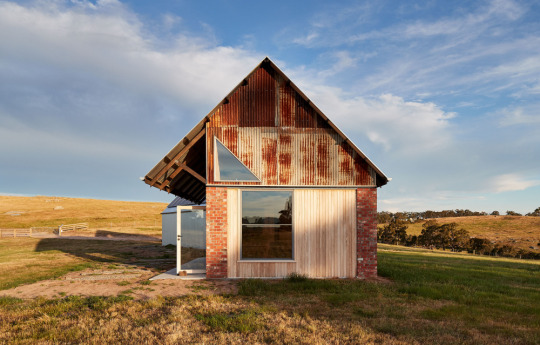
Nulla Vale by MRTN Architects. Photo – Peter Bennetts

Good Life House by MRTN Architects. Photo – Dave Kulesza. Styling – Bea+Co
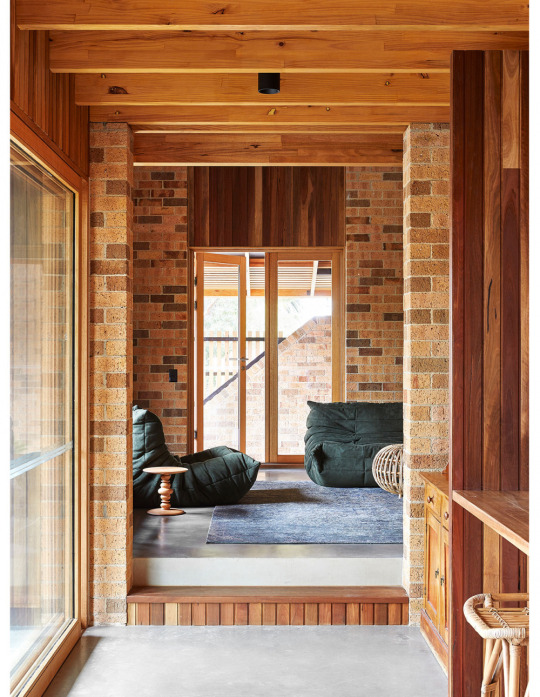
Good Life House by MRTN Architects. Photo – Dave Kulesza. Styling – Bea+Co
What does an architect do?
Think of an architect as the head of your home’s design and build team, that may include interior designers, structural engineers, landscape architects, building surveyors and builders.
‘Architects are the only people in the building industry that are regulated to manage an entire project, from design and through the whole construction process,’ says Albert Mo, director of Architects EAT.
‘While we are the mastermind behind the aesthetic and pretty spaces, more importantly we are the logical mind who processes your wishes to combine with building regulations, sustainability and budget, to arrive at the end result.’
Architects are also problem solvers, possessing a unique skillset that’s both creative and technical.
‘We get to use both the right and left sides of the brain to create elegant solutions to spatial problems,’ says Antony Martin, director of MRTN Architects. ‘We have the capacity to creatively resolve technical challenges and use technical know-how to bring creativity to life.’

Shadow Cottage Daylesford by MRTN Architects. Photo – Eve Wilson for The Design Files. Styling – Annie Portelli

Shadow Cottage Daylesford by MRTN Architects. Photo – Eve Wilson for The Design Files. Styling – Annie Portelli
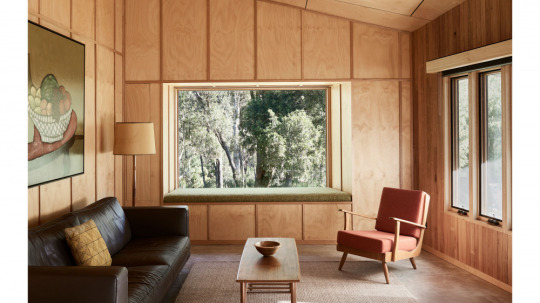
Shadow Cottage Daylesford by MRTN Architects. Photo – Eve Wilson for The Design Files. Styling – Annie Portelli
What services can an architect offer me?
Like other design professionals, architects structure their work in stages roughly encompassed under three umbrellas: design, documentation, and contract administration.
The design phase encompasses everything from an initial consultation through to the production of drawings, models and visualisations of the finished building.
The documentation phase is where separate drawings and documents for project approvals (where required) and construction are created. The finer details of the design will also be decided at this point, right down to the kitchen sink.
Finally, contract administration is where an architect works with the builder to help the construction process occur smoothly and efficiently. Usually your architect will act on your behalf throughout this process to check contractors are paid, questions are answered, and timely opportunities to tweak the design are realised, as the build progresses.

Thornbury Townhouses by Fowler and Ward. Photo – Tom Ross
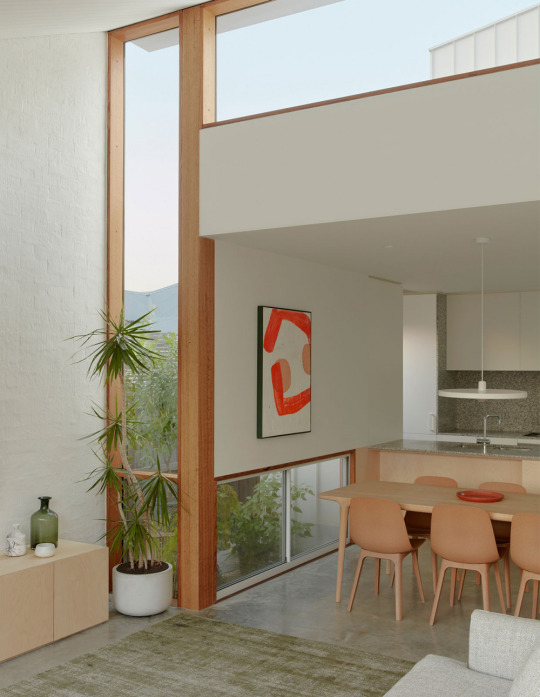
Thornbury Townhouses by Fowler and Ward. Photo – Tom Ross
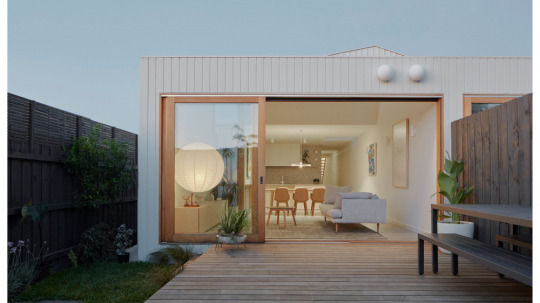
Thornbury Townhouses by Fowler and Ward. Photo – Tom Ross
Can an architect also improve the sustainability of my home?
Focusing on sustainability is an inherent part of any good architect’s process. Don’t think of this as its own design stage, but an embedded element of the overall project.
‘Sustainability is an integral part of the design process and not something applied later as an add-on,’ says Antony. ‘Decisions about solar orientation, location of thermal mass, insulation, windows, heating and cooling systems and materiality are all essential parts to the design, and each of those parts is critical to the creation of a sustainable home.’
Architects can also specify additional systems to improve your home’s energy efficiency including solar systems, batteries, and water retention systems, says Tara Ward, co-director of Fowler and Ward.
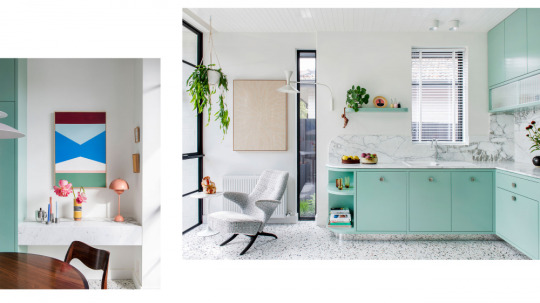
Flemington House by Lisa Breeze Architect. Photo – Cathy Schusler. Styling – Natalie James

Flemington House by Lisa Breeze Architect. Photo – Cathy Schusler. Styling – Natalie James
Can I engage an architect to makeover just one section of my house, or does it have to be the entire home?
Generally speaking, yes you can engage an architect to design or renovate just one section of your home. The work of MRTN Architects, for example, ranges from complete new homes right down to small renovations such as kitchen and bathroom makeovers.
With that being said, many architects prefer to work on a home’s entire floor plan rather than a singular element (such as a new addition). This approach allows them to consider how rooms relate to one another, where light comes from, how the orientation affects the internal comfort, and more.
‘Most architects would ideally like to have some involvement in the entire home, to ensure that everything works together, says Jessie Fowler, co-director of Fowler and Ward. ‘On the other hand, if a client comes along with a tiny project but they want to push the boundaries and create something unique, then we might consider working on a limited area such as a kitchen or living space.’
You may not even know what level of intervention is required, which is why Antony recommends engaging an architect early in the project for their advice. ‘We often work with clients to define exactly what the nature of the project should be; a renovation or a new-build, larger or smaller, viable or not,’ he says.
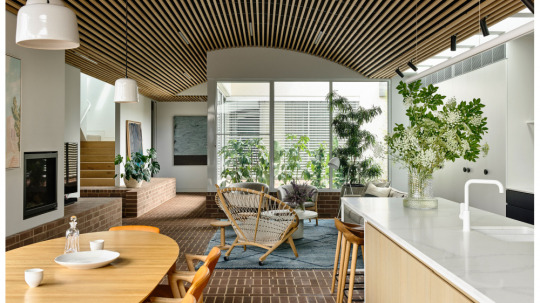
Carpenters Square House by Architects EAT. Photo – Derek Swalwell. Styling – Swee Design

Carpenters Square House by Architects EAT. Photo – Derek Swalwell. Styling – Swee Design
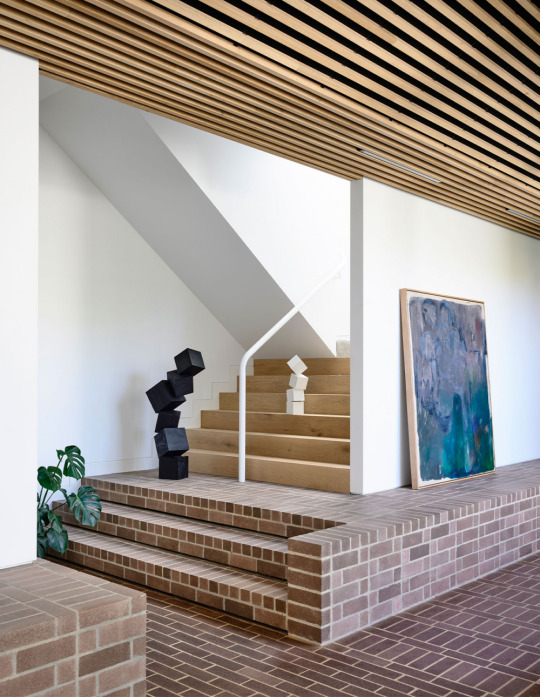
Carpenters Square House by Architects EAT. Photo – Derek Swalwell. Styling – Swee Design
How are architecture fees calculated?
Every practice has their own way of calculating fees, however, a common method is to charge a percentage of the estimated total cost of construction. The exact percentage charged depends on the complexity of the project, which can sometimes outweigh other factors such as the floor plan size.
Antony explains, ‘An addition to a Victorian terrace house in a heritage overlay is more complex and takes longer to resolve than a new house on a flat piece of farm land. Our fees for new homes or large alterations/additions that do not require a planning permit are 9-11% of the total construction budget, while smaller projects alterations/additions are around 12-14%.
Fowler and Ward also charge a percentage-based fee, which varies from about 8-12% of a project’s total construction cost.
For comparison’s sake, of all the architects we spoke to (all of which are based in Melbourne), the total construction cost of projects they’ve worked on has been between $300,000 (for a new addition only) and $10 million (for a 1000 square metre house).
‘A home with a complicated form and hidden box gutters will cost more than one with a simple shape, standard construction details, and simple structural solutions. A laminate kitchen will be more cost effective than one with plenty of timber and stone,’ says architect Lisa Breeze from Lisa Breeze Architect who runs her own practice. ‘Costs also tend to vary between the inner city and coastal and rural areas.’
Other practices including Lisa’s and Architects EAT charge an hourly fee or fixed fee, based on their experience designing similar sized and detailed projects. ‘This means that if you chose an expensive stone rather than a cost-effective stone, for example, you don’t pay us more for that decision,’ says Albert.
When you reach out to an architect, be sure to ask them how they calculate their project fees, and their level of experience.
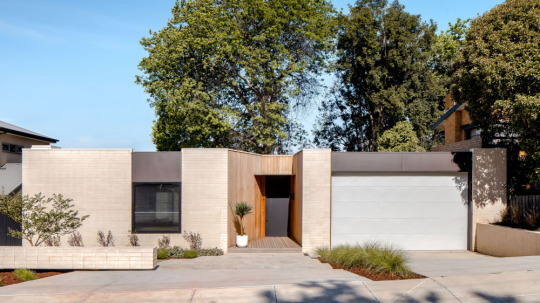
Pivot House by Architects EAT. Photo – Chris Murray. Styling – Anna Botsaris
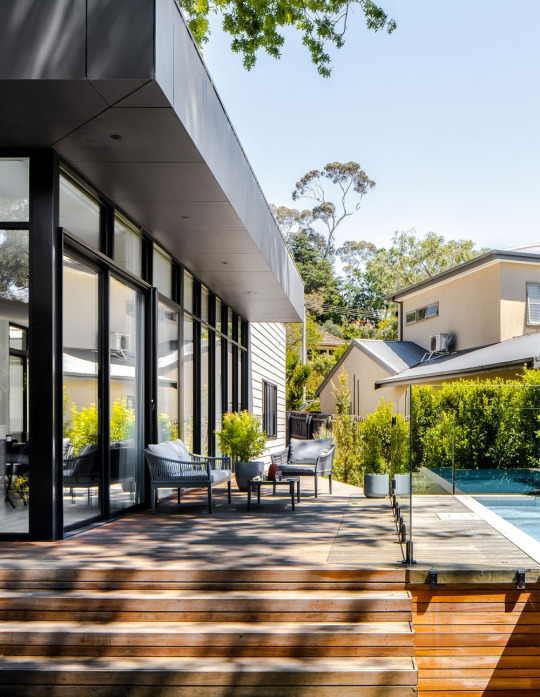
Pivot House by Architects EAT. Photo – Chris Murray. Styling – Anna Botsaris

Pivot House by Architects EAT. Photo – Chris Murray. Styling – Anna Botsaris
How long do the design and construction phases take?
The answer to this question again varies, however, for an architectural project in a built-up area – and particular in areas of heritage overlay – the design and documentation phase, resulting in approved council permits, generally takes around one year, but some councils may make this process even longer.
‘A fast application could be four to six months, and a lengthy application may be two to three years,’ says Albert of council approvals.
From there, the typical dwelling construction phase is usually an additional 12-18 months.
0 notes
Text
This New York-Style Warehouse Apartment Is The Dream Melbourne Rental!
This New York-Style Warehouse Apartment Is The Dream Melbourne Rental!
Homes
by Lucy Feagins, Editor
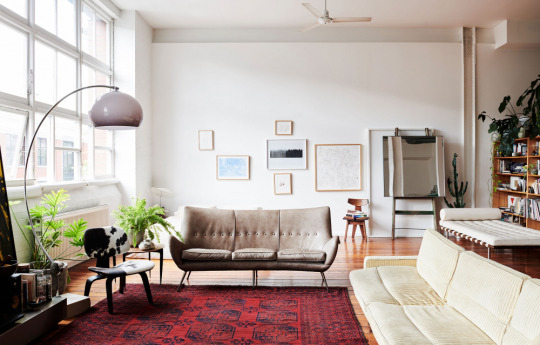
Three-seater curved sofa crafted in Italy in the 1950s and newly upholstered in aged brown Italian leather by Nicholas & Alistair. Mid-century adjustable arc floor lamp from Modern Times. Photo – Eve Wilson for The Design Files. Styling – Annie Portelli.
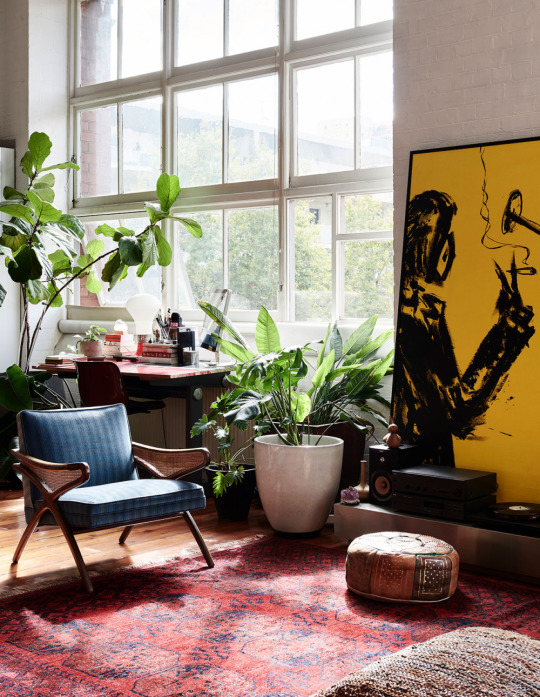
Circa 1960s blackwood chair with rattan (‘possibly by Jakob Rudowski!’). Photo – Eve Wilson for The Design Files. Styling – Annie Portelli.

The small line drawing of two figures is by James Watkins. Blue sky painting by Andy Murray of Aster Studio. Fritz Hansen Tray Table. Photo – Eve Wilson for The Design Files. Styling – Annie Portelli.
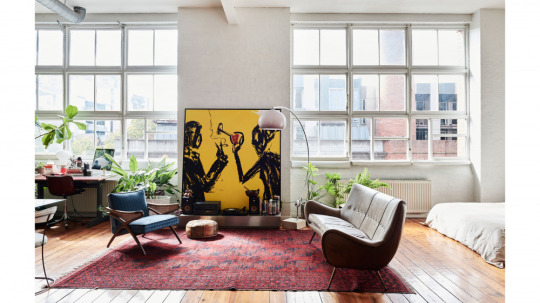
The large, yellow artwork is by Melbourne artist Doug Bennett. ‘The rug was sourced by Erika’s good friend Olivia via her friends in Istanbul. ‘The singing bowl is from Nepal when I travelled to Everest basecamp,’ says Erika. Photo – Eve Wilson for The Design Files. Styling – Annie Portelli.

The island bench in the kitchen is a French antique from Erika’s stepmum. Battery Vase by Tarlo & Graham. Photo – Eve Wilson for The Design Files. Styling – Annie Portelli.
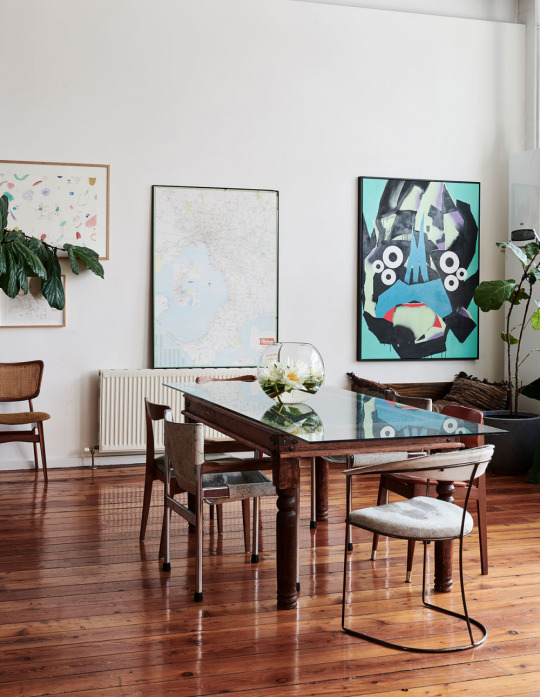
‘My dad has restored several of my dining room chairs, which he found during neighbourhood hard rubbish collections – they have a significant sentimentality,’ says Erika. Photo – Eve Wilson for The Design Files. Styling – Annie Portelli.
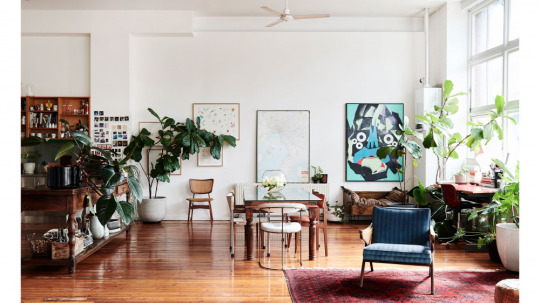
Dog bed is by Toby & Co. Melbourne Metro artwork by an unknown artist. Bright artwork by Mysterious Al. Illustrations by Andy Murray of Aster Studio. Photo – Eve Wilson for The Design Files. Styling – Annie Portelli.
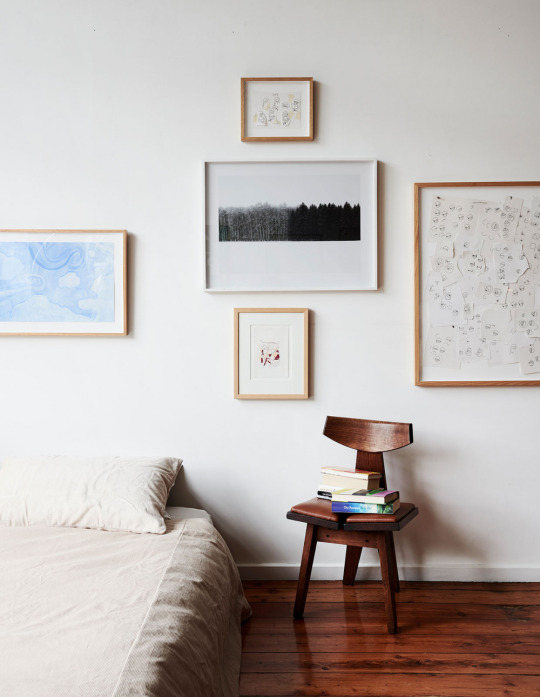
‘Most of the art in my house is by my close friend, Andy Murray of Aster Studio,’ says Erika. ‘We wrote a children’s book together with my friend Charl, and the original illustrations are the main frames in my house.
The black and white forest photograph is by Hartwig Klappert, I stayed in his house in Berlin in 2014 or 2015 and it was one of the most memorable experiences of my life, his work was so inspiring and this was a memento.’ 1950s Aloha Chair by Kjell Grant. Photo – Eve Wilson for The Design Files. Styling – Annie Portelli.
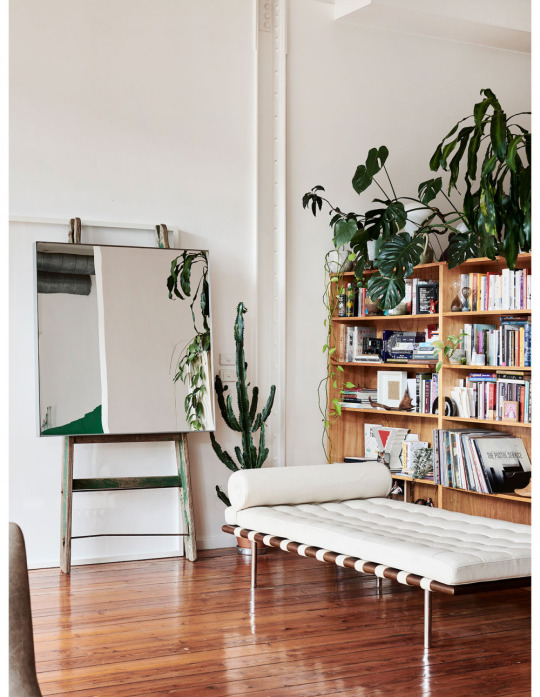
Barcelona daybed from Modern Times. Easel mirror from Nook Vintage in Collingwood. Photo – Eve Wilson for The Design Files. Styling – Annie Portelli.
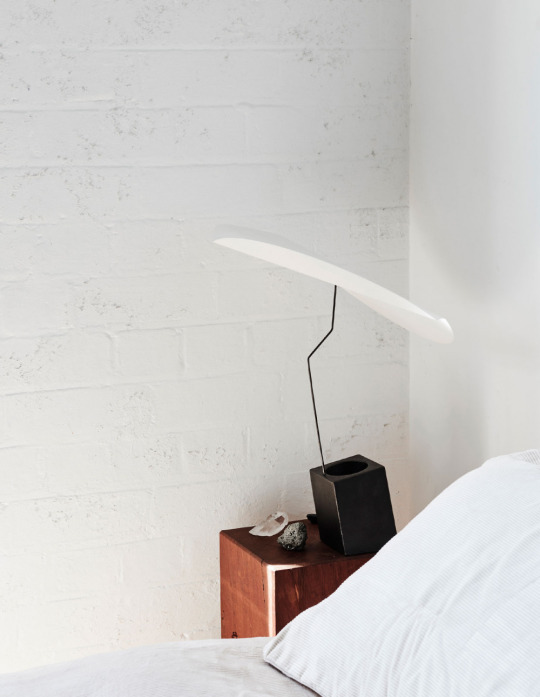
Float lamp bought in France. Wooden bedside table made by Erika’s friend, Matthew Carmody. Photo – Eve Wilson for The Design Files. Styling – Annie Portelli.

Corduroy bedding is from The Sheet Society. 1950s Aloha chair by Kjell Grant. Photo – Eve Wilson for The Design Files. Styling – Annie Portelli.
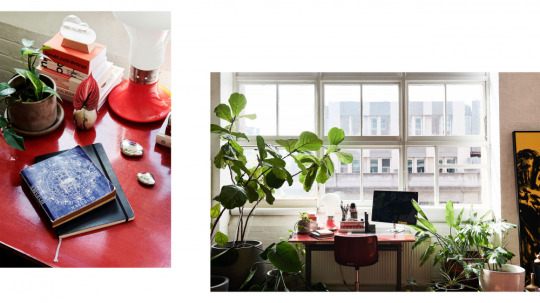
Working from home set-up goals! Most plants from Loose Leaf Studio and Brunswick Street Nursery – they’ve gotten this tall from eight years of sun. The architect’s desk was left behind at Erika’s old apartment in Cremorne, and has travelled with her for the last 10 years. Vintage red and white table lamp by Mazzega, Italy c1970s. ‘Be Here Now’ by Ram Dass and Moleskine diary. Fluff Bronzing Powder & Lip Oil refillable compacts. ‘I’m obsessed with clouds, and three people have gifted me this Cloud Weather Station, including my twin sister in Japan,’ says Erika. Small, round handmade pottery vase made by a friend. Photo – Eve Wilson for The Design Files. Styling – Annie Portelli.

‘I have purchased most of my furniture from Smith St Bazaar, including the Edra Spiral Tatlin black velvet sofa . ‘Their selection is incredible and I highly recommend people consider places like theirs before bigger, commercial brands or retailers’ says Erika of the store. See the owners’ home here! Photo – Eve Wilson for The Design Files. Styling – Annie Portelli.

‘This section of the apartment became our Fluff office after we moved out of our Gertrude Street Store during Covid, so it’s a little different aesthetically from the rest of my apartment,’ says Erika. Oblique Red Bookshelf by Moooi. Fluff products including face oils, cleanser, face mask, kabuki brush, bronzing powder and lip oil metal compacts. Photo – Eve Wilson for The Design Files. Styling – Annie Portelli.
The converted warehouse apartment of Erika Geraerts is essentially just one large room, and that’s exactly the way she likes it!
The writer and founder of beauty brand Fluff has been living here since 2013, and slowly furnishing the space ever since. The apartment is part of the former Foy & Gibson complex – reportedly the largest factory in the Southern Hemisphere at one stage in the early 1900s. The factory was converted into apartments in the 1990s, representing some of Collingwood’s most sought-after real estate for renters and homeowners alike. ‘I’ve never experienced a neighbour community like this, and I don’t think I’d have it any other way,’ Erika says.
Erika loves the building’s large industrial windows and the ‘blank canvas’ nature of the interiors. ‘Waking with the morning light and seeing it fill the room is my favourite way to start the day,’ she says.
Ask some people where they bought their furniture or homewares and they won’t remember – but not Erika. Point to anything in this home and she’ll happily tell you where she found it, and why it’s the perfect piece for the space. ‘Everything tells a story, everything means something to me – even the salt and pepper shakers,’ she says. ‘There was a point where I wanted to challenge myself to find pieces that I liked, not because anyone else did, but because I felt something when I looked at it or sat in it,’ she says.
It’s not just aesthetics Erika is concerned with, but also the experiences her home offers. ‘I want my space to feel comfortable, but speak to my personality, and the people who come over for dinner. That’s why every chair is different; I started with one around the dining table, and slowly found different ones over the years.’
Soft lighting, local art, vintage Italian furniture, and plants bring warmth and texture to the space, tying everything together. Erika has purchased most of her vintage furniture from Smith St Bazaar, including her cherished Edra Spiral Tatlin black velvet sofa. ‘I consider [the owners of Smith Street Bazaar] Eddie and especially Eryca close friends; they understand my style and my apartment and have been so amazing in showing me pieces and introducing me to designers’ work that I would never have imagined, but have fallen in love with over time’ Erika explains.
Eight years is a long time by Melbourne renting standards, but Erika hopes she’ll be living here for another eight years and beyond. ‘This space has been my saving grace over the years. I can’t imagine ever not being here in some capacity.’
0 notes
Text
Bring The Pizazz Back To Home Entertaining, With A DIY Home Bar!
Bring The Pizazz Back To Home Entertaining, With A DIY Home Bar!
Interiors
Lauren Li

The Brighton Residence by Golden. Photo – Sharyn Cairns.

Marty Gilchrist and Erica Frick’s house in West Footscray. Photo – Caitlin Mills for The Design Files.
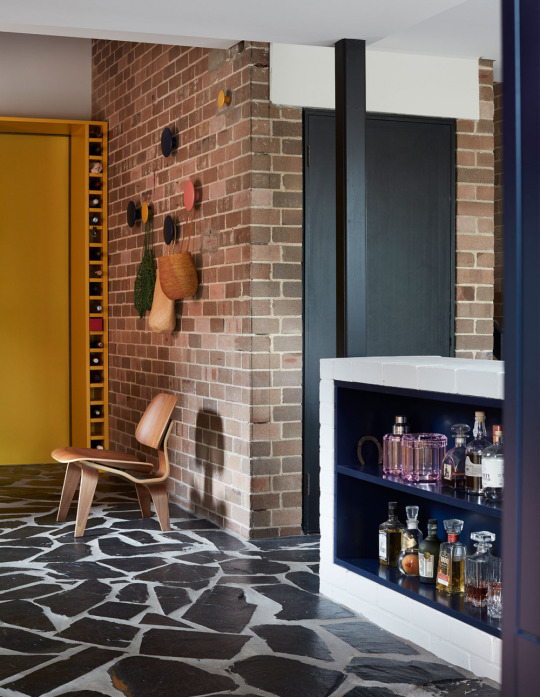
YSG Studio Polychrome House. Photo – Prue Ruscoe.
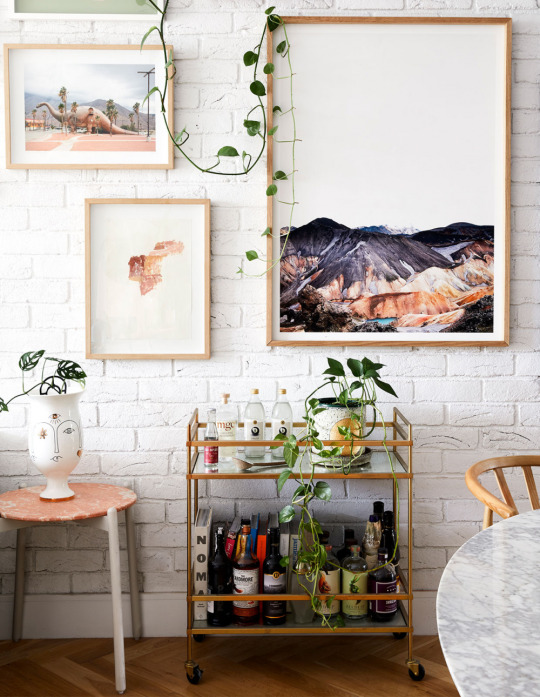
Jono Fleming’s Home. Bar cart from West Elm. Photo – Caitlin Mills. Styling – Annie Portelli.
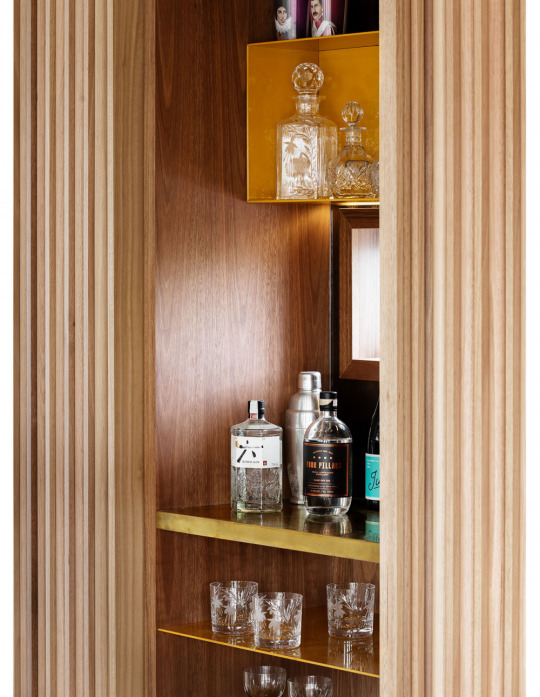
Home of Rosalind Willett by Wowowa Architects. Photo – Martina Gemmola. Styling by Ruth Welsby.

Home bar details. Photo – Eve Wilson.

The Design Files Open House bar made by Gordon Johnson using terrazzo from Signorino Tile Gallery. Photo – Eve Wilson.
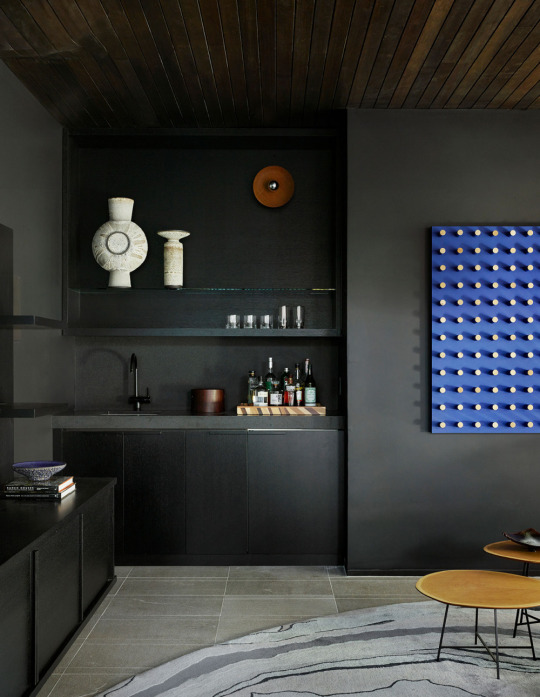
San Fransisco Townhouse Bar & Game Room by Jamie Bush + Co. Photo – Matthew Millman.
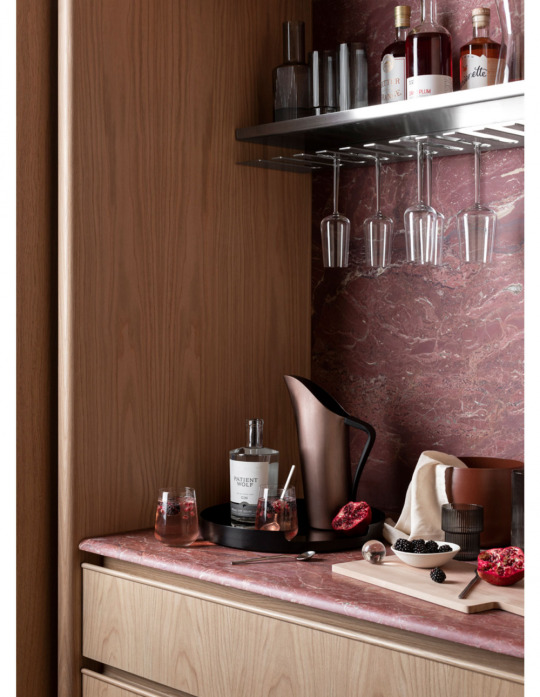
Cantilever Kitchens’ new EDIT design Photo – Martina Gemmola

Fiona Lynch’s St Kilda Apartment. Photo – Tom Ross.
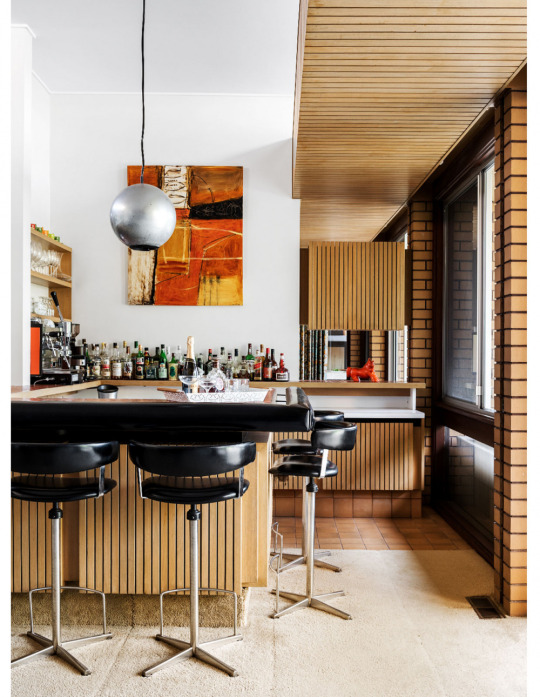
Heidelburg Home. Photo – Joel Noon.
With the seventies trending big time right now in interiors, we’re re-living low, laid-back sofas, cane furniture, and indoor plants. Honestly, it was only a matter of time before the home bar would re-emerge too! I know what you’re thinking… but this is not a ‘straight to the pool room’ type of freestanding bar!
The home bar has been reinvented. Think smart, built-in joinery (if you’ve got the luxury of building) or a delightful drinks trolley, or even just a dedicated tray with some snazzy cocktail accessories.
Now that home entertaining is finally back, it might be time to give your alcohol station a bit of the old razzle-dazzle. Don’t worry… we got you!

Kun Design Pipe Bar Cart, $1,125. Available from Domo.
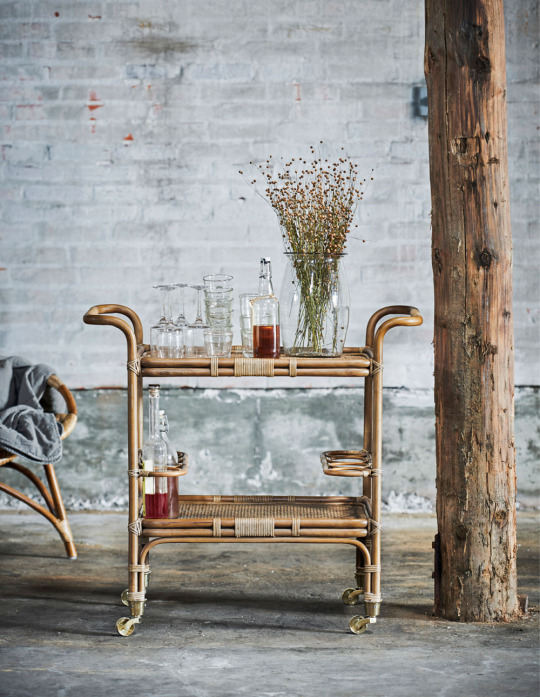
Carlo Bar Trolley by Sika Design, $695. Available from Domo.

Artek Tea Trolley, $3,696. Available from Anibou.

Trace Drinks Trolley, $2178. Available from Tait. Photo – Eve Wilson.
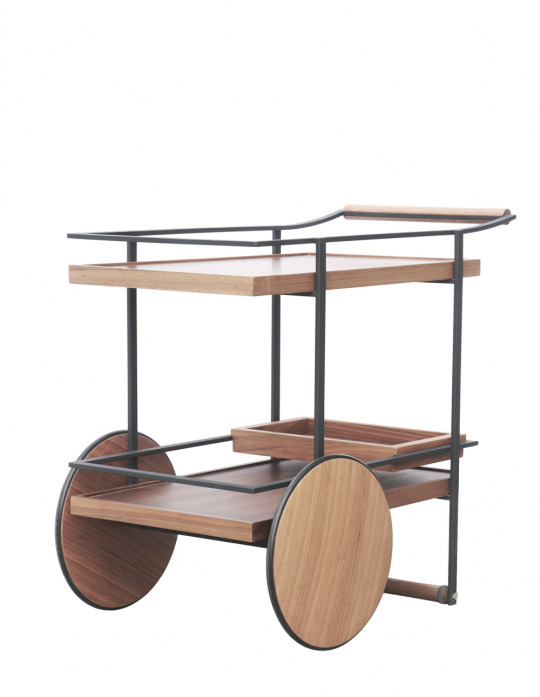
James Bar Cart by Stellar Works, $3,595. Available from Living Edge.

Alfredo Häberli for BD Barcelona Happy Hour Trolley, $2,506. Available from Ajar
Bar Carts
A bar cart is one of those pieces that you didn’t realize that you needed, but once you have one you can’t imagine living without!
They are a very ‘grown-up’ addition to a dining area, and provide an opportunity to flex your styling muscle. You want to strike a balance of a nice-looking bar cart, yet with an emphasis on functionality – so we can mix up a cocktail at a moment’s notice.
It’s not essential to include every single liquor bottle that you own on the bar cart, just edit out the old ones that you don’t use often. Mix in some décor pieces with the bar tools you need for mixing up a delicious cocktail (shaker, jigger, muddler etc). Hang an artwork above, and hey presto – you have your own stylish home bar.
Kun Design Pipe Bar Cart, Available from Domo.
If you’re lucky enough to be entertaining by the pool, roll out this baby and enjoy a chilled refreshment – extra points to this guy for being suitable for the outdoors!
Carlo Bar Trolley by Sika Design. Available from Domo.
This handmade drinks trolley is made sustainably in Indonesia and it certainly gives out those relaxed boho vibes.
Tea Trolley by Artek. Available from Anibou.
Although this piece was initially intended for tea, I see no reason to stock it with the hard stuff!
Trace Drinks Trolley. Available from Tait
You cannot beat the fab powder coated colours of this handsome contemporary bar cart from Tait! (Again, suitable for indoors or out).

Buster + Punch, The Rockstar Bar, $12,130. Available from Living Edge.

Medium shelving unit by Techne Architecture + Grazia and Co, available from Grazia and Co.
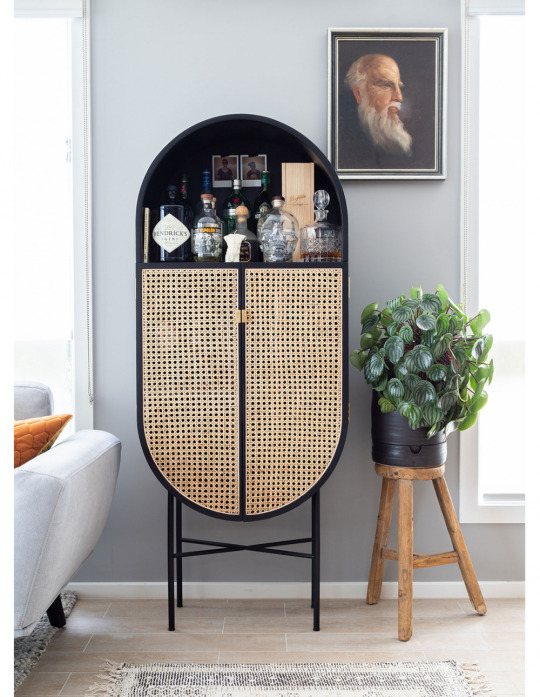
Black retro webbing oval cabinet by HK Living, $1,695. Available from House of Orange.
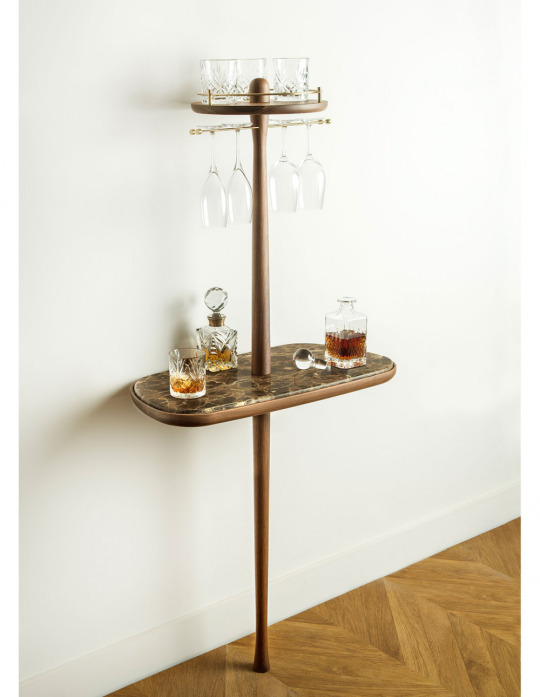
Nomon for Nomon Bar stand, $3,539. Available from Ajar.
Bar Cabinet
If a moveable (drinks) feast is not quite your style, then a bar cabinet could be just the ticket for a more permanent fixture.
A slightly more mature option, the bar cabinet is somewhere between a drinks trolley (see above) and a built-in bar (reserved for very bougie occasions only!).
These freestanding pieces mean you can conceal (and reveal) the booze from display, as needed.
Buster + Punch, The Rockstar Bar. Available from Living Edge.
Okay… so this one is just a little bit fancy… but dare to dream! Feeling those Don Draper vibes with this ‘Rockstar’ bar… it must be 5pm somewhere, right?
Medium shelving unit by Techne Architecture + Grazia and Co. Available from Grazia and Co.
A statement piece with an architectural edge – fitting, given it was designed by Techne Architecture!
Black retro webbing oval cabinet by HK Living. Available from House of Orange.
This cabinet is a delightful solution to keep some of the bar things on display, whist hiding other messy stuff in the cupboards.
Nomon for Nomon Bar stand. Available from Ajar.
Okay, so this isn’t *quite* a cabinet, but I thought it still deserved a spot here. This is a compact solution for small spaces, but it also is totally unique and elegant. A neat solution for storing glassware and a mini bench for pouring – genius!

Ripple Long Glass ($85 for set of 4), Fein Long Spoon ($23) and Fein Tipping Measure ($29). All available from Ferm Living.

Grib Tray ($100), Alza Ice bucket ($332), Ripple Long Glass ($85 for set of 4). All available from Ferm Living.

Pale Orange tumbler ($50) and pitcher ($145). Available from Lope Home.
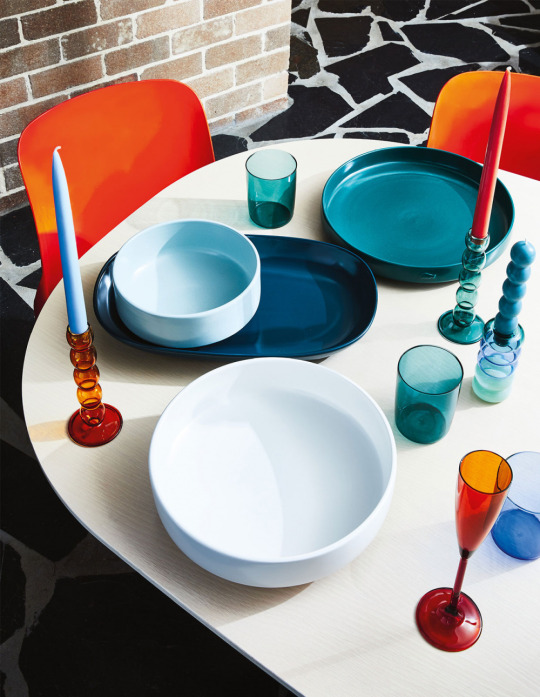
Maison Balzac champagne flutes ($79 for a set of 2) and goblets ($69 for a set of 4). Available from David Jones – as seen in the latest issue of Jones magazine (available in store now!).
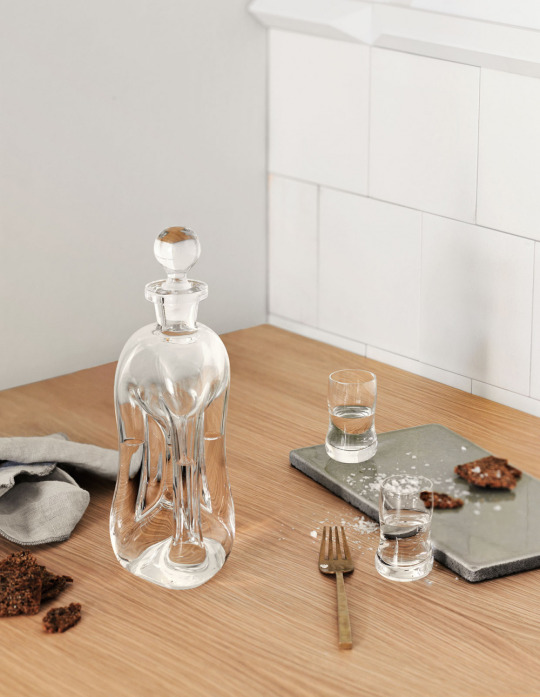
Klukflaske, $275. Available from Great Dane.

Rock Candy Cup by Danielle Rickaby ($99). Available from JamFactory.
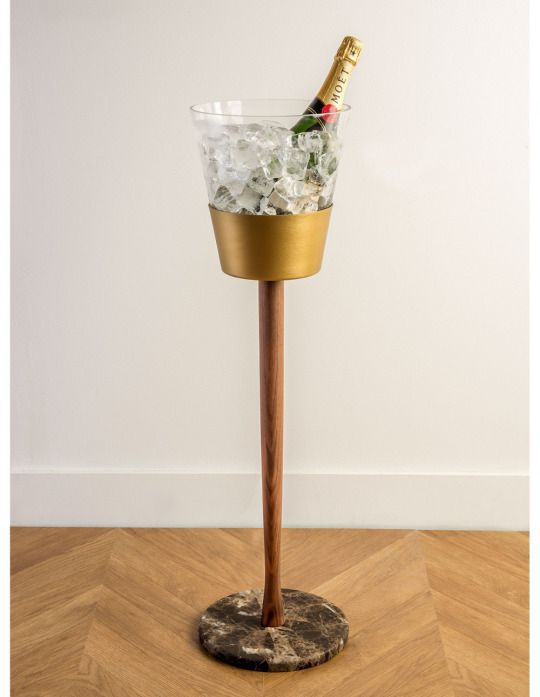
Nomon champagne bucket, $1,071. Available from Ajar.

Optic Jug Designed by the 2019 JamFactory Associates, $230. Available from JamFactory.
Accessories
Having the right equipment on hand means that mixing the perfect cocktail is as pleasurable an experience as enjoying the results – it’s all about the journey, not just the destination, right?
You’ve watched the YouTube tutorial on how to make the perfect cocktail, then you’ve muddled, stirred, strained and/or shaken your concoction into the most divine cocktail glassware. It almost feels like you are back in Bali, and not surrounded by a pile of washing in your living room. That is the power of a strong cocktail, my friends!
Ripple Long Glass, Fein Long Spoon and Fein Tipping Measure. All available from Ferm Living.
Nothing says ‘lockdown bartender’ like a few snazzy accessories to swizzle with – I love the tipping measure and long spoon combo with these fab tall glasses!
Grib Tray, Alza Ice bucket , Ripple Long Glass . All available from Ferm Living.
This round drinks tray is absolutely GENIUS for portable drink dispensing, and the ice bucket takes it to the next level. A tray might be all you need to create a dedicated cocktail mixing area at home.
Lope Home Pale Orange tumbler and pitcher. Available from Lope Home.
These pitchers and tumblers take on a fluid quality, dipped in sublime colour. Made here in Melbourne, too!
Maison Balzac champagne flutes and goblets. Available from David Jones./
Australian homewares brand Maison Balzac was way ahead of the coloured glassware trend before the rest of us caught up – they even do champagne flutes in a range of hues. Love!
Klukflaske. Available from Great Dane.
Almost like a droplet of water itself, the Klukflaske is made of mouth-blown transparent glass, which makes it particularly decorative with either whisky or cognac in it on the bar trolley. It makes a special glug-glugging sound when the liquid is poured from the bottle.
Rock Candy Cup by Danielle Rickaby. Available from JamFactory.
These glass tumblers by Danielle Rickaby of Yo Dan are truly a work of art!
Nomon champagne bucket. Available from Ajar.
I’m not sure I’ve ever seen a piece that screams ‘good time!’ more than this delicious champagne bucket – how glam!
Optic Jug. Available from JamFactory.
This handblown blown coloured glass jug that is made in Australia will add a pop of colour to any home bar.
0 notes
Text
The Greatest, Escapist Homes Of 2020!
The Greatest, Escapist Homes Of 2020!
Roundup
Sasha Gattermayr
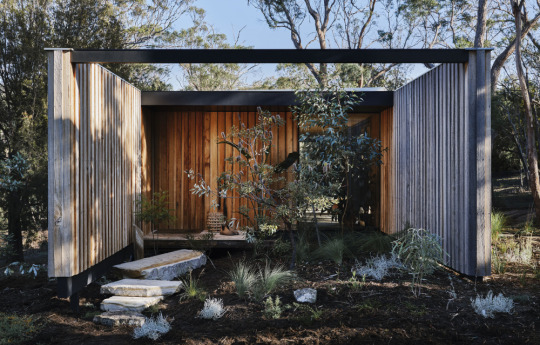
Casa Acton by Josh FitzGerald of Archier. Photo – Adam Gibson.
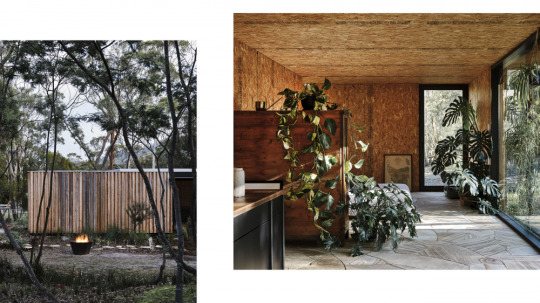
Casa Acton by Josh FitzGerald of Archier. Photo – Adam Gibson.
An Architect’s Own Hideaway, Buried In The Tasmanian Bushland
Casa Acton is the home of Archier‘s technical director Josh FitzGerald, which he built himself, by hand. Located in the Hobart suburb of Acton Park, this modest, cabin-like home made from locally sourced building materials is perfectly in sync with its bushy surrounds.
Revisit the original story here!

Cliff House by Auhaus Architecture. Photo – Derek Swalwell. Styling – Bek Sheppard.
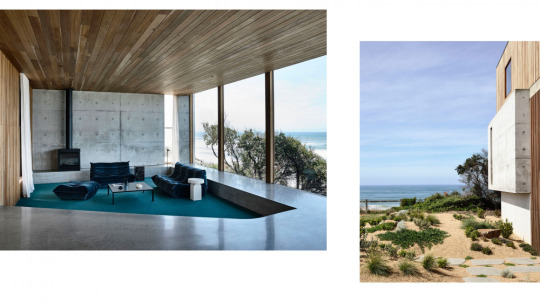
Cliff House by Auhaus Architecture. Photo – Derek Swalwell. Styling – Bek Sheppard.
An Ocean-Side Sanctuary Designed To Age Gracefully
This grand beachside home in Ocean Grove represents a confluence of opposing factors. Located on a windswept sand dune overlooking the Barwon bluff on one side, and the Point Lonsdale lighthouse on the other, it is exposed to both the beauty and the intensity of such a rugged beachfront spot.
When designing Cliff House, Auhaus Architecture chose to reflect the rugged location in material expression, opting for raw and natural materials at every opportunity.
Revisit the original story here.

The ‘tent house’ in Noosa by Sparks Architects. Photo – Christopher Frederick Jones.
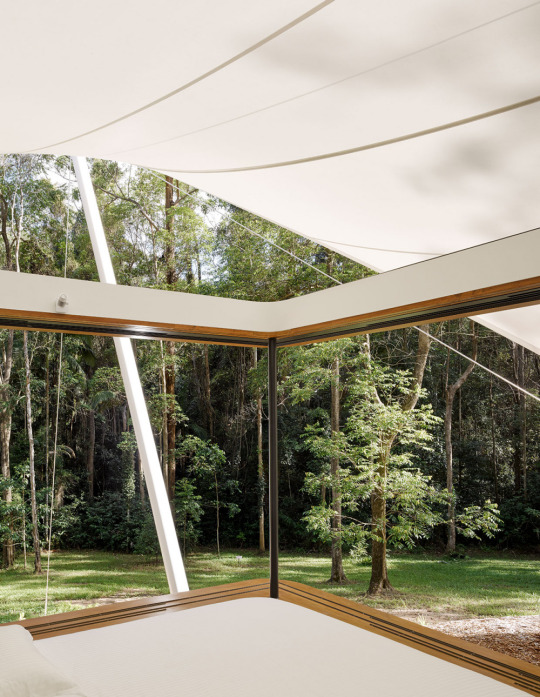
The ‘tent house’ in Noosa by Sparks Architects. Photo – Christopher Frederick Jones.
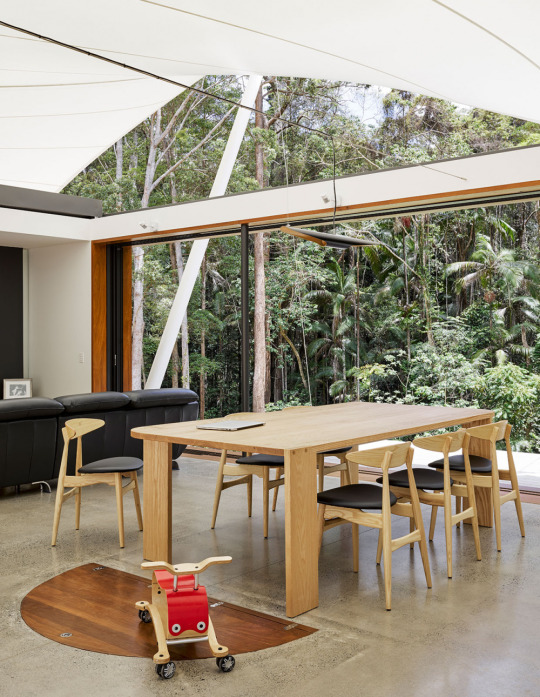
The ‘tent house’ in Noosa by Sparks Architects. Photo – Christopher Frederick Jones.
An Unconventional ‘Tent House’ In The Noosa Hinterland
This ‘tent house’ by Sparks Architects was inspired by the ultimate ‘gone bush’ activity: camping under the stars. The innovative design facilitates two distinct modes of living – one where the home’s roof and walls are wide open, and the other where the house functions as an insulated box.
Designing and building a tent-like residential structure is a huge and impressive undertaking – so much so that you actually might recognise it from Grand Designs Australia!
Revisit the original story here.

A family home in Red Hill, Victoria designed by InForm and Pleysier Perkins. Styling – Bek Sheppard. Photo – James Geer.
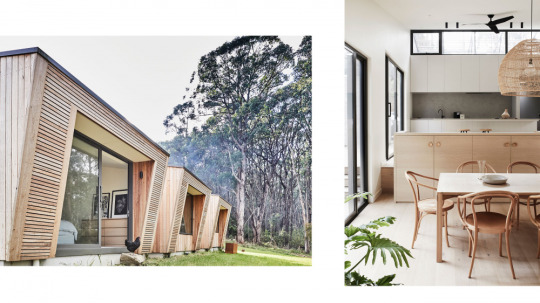
A family home in Red Hill, Victoria designed by InForm and Pleysier Perkins. Styling – Bek Sheppard. Photo – James Geer.
A Family Home That Mirrors Nature
Jane and Lloyd Fenn and their children Lillian, 11, Audrey, 10, and Eddie, 6, moved from Melbourne to the Mornington Peninsula with the hopes of better connecting to nature – something they’ve achieved in the design of their beautiful home.
Their family home in Red Hill, Victoria, has been designed in direct response to its sloping, bush block. But rather than flattening the site, the designers decided to lean into its existing conditions, developing a tiered floor plan that naturally distinguishes different areas of the home. Designed and built by InForm in collaboration with Pleysier Perkins architects, the house is clad with locally-sourced rough sawn timber, and seamlessly blends into its natural surrounds.
Revisit the original story here.
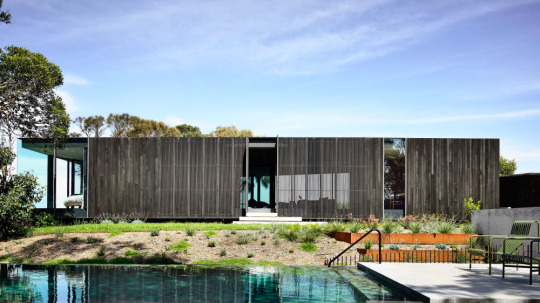
Bluff House by Rob Kennon Architects. Photo – Derek Swalwell.
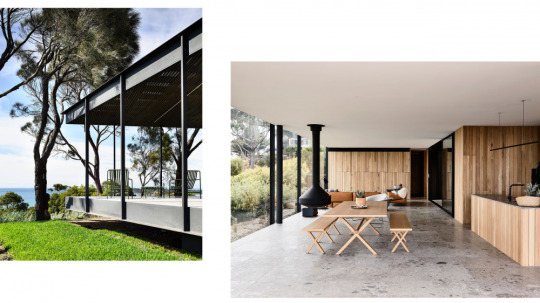
Bluff House by Rob Kennon Architects. Photo – Derek Swalwell.
This Non-Conventional Holiday Home Is Mostly Underground
Bluff House is located in a landslip zone, meaning the majority of the structure had to be built into the foreshore rather than on top of it. By anchoring bedrooms underground with a cantilevered living domain above, Rob Kennon Architects have mastered this site’s challenging requirements, while maximising the views from an almost entirely subterranean position! Incredible!
Revisit the original story here.

The Two Sheds house by Roger Nelson of NH Architecture and DREAMER. Photo – Rory Gardiner.
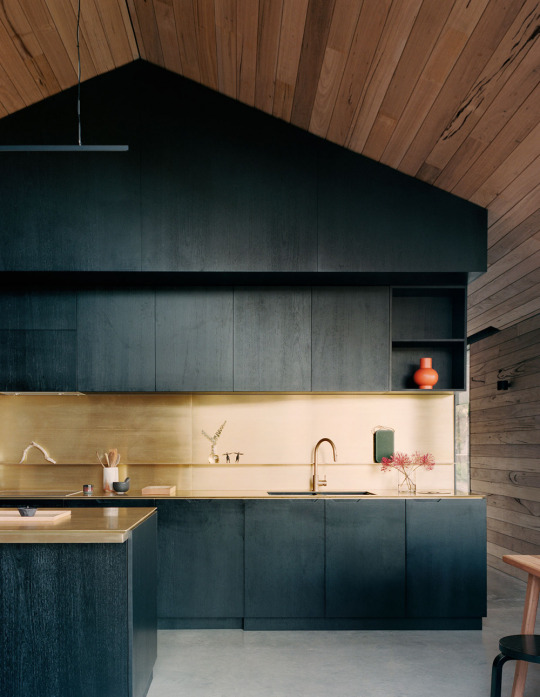
The Two Sheds house by Roger Nelson of NH Architecture and DREAMER. Photo – Rory Gardiner.

The Two Sheds house by Roger Nelson of NH Architecture and DREAMER. Photo – Rory Gardiner.
This Lorne Home Is A Dream Collaboration Between Two Architects
On a bush block just outside Lorne, Victoria, lies the holiday home of architect Roger Nelson. In collaboration with DREAMER, the original plans for a sprawling 700sqm home were reduced to 220 square metres across two linked but distinct pavilions. Though technically belonging to Roger and his wife Jane, the house has been designed to cater for generations of children and grandkids alike to escape from the city to reconnect with one another and the outdoors.
Revisit the original story here.
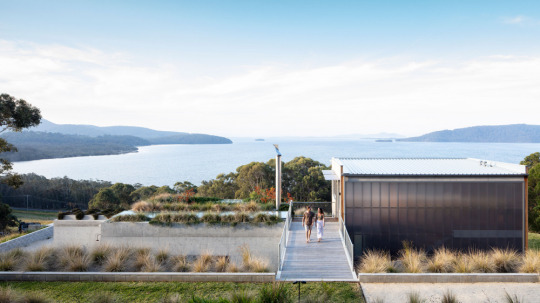
The Wallis Lake House by Matthew Woodward Architecture. Photo – Brett Boardman.
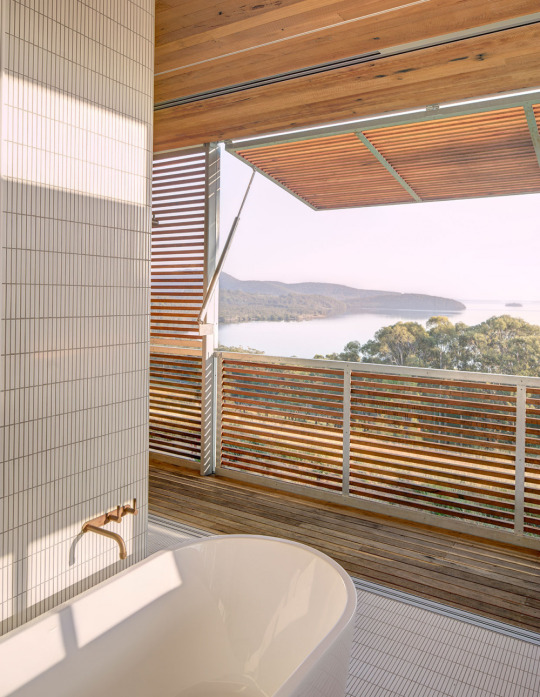
The Wallis Lake House by Matthew Woodward Architecture. Photo – Brett Boardman.

The Wallis Lake House by Matthew Woodward Architecture. Photo – Brett Boardman.

The Wallis Lake House by Matthew Woodward Architecture. Photo – Brett Boardman.
A Breathtaking Lake House Completely Open To Its Natural Surrounds
Hold onto your hats, this one might just knock the wind out of you! Matthew Woodward Architecture were engaged to create a sturdy but experimental residence atop this windswept 25-acre property overlooking Wallis Lake on the north coast of New South Wales. The awe-inspiring result is a robust dwelling, crafted from rough and raw textures that will weather with time, and blends seamlessly into the rugged surrounds.
The north-facing house opens itself to the elements, utilising sliding glass doors on the lower levels and hydraulic levered timber screens on the upper floor to unfold the residence out onto the property. With bushland at the rear of the property and rolling, unimpeded views down to Lake Wallis, maximum connectivity to the natural surrounds was the central design concern. These are probably the most spectacular views we saw all year!
Revisit the original story here.

Coastal Luxe at St Andrews Beach on the Mornington Peninsula. Photo – Jarno Jussila.

Coastal Luxe at St Andrews Beach on the Mornington Peninsula. Photo – Jarno Jussila.

Coastal Luxe at St Andrews Beach on the Mornington Peninsula. Photo – Jarno Jussila.
A Modernist-Inspired Getaway On The Mornington Peninsula
St Andrews Beach is a seldom mentioned slice of Victoria’s Mornington Pensinsula. Wedged between Cape Schanck and Sorrento, the rugged coastline faces Bass Strait rather than the bayside views favoured by the more popular townships on the opposing side of the coastal strip.
Kerryn Nossal and her partner bought their plot of land in the St Andrews dunes in 2000, and proceeded to build the Coastal Luxe beach house over the next 15 years. Enter the property through a landscaped banksia forest and ascend the multi-level house all the way to the top where a the main bedroom suite sits like a nest in the treetops. You can even catch a glimpse of the expansive seaside vista through a 6.5-metre window that runs along the spine of the house. Who could want anything more?!
Revisit the original story here.
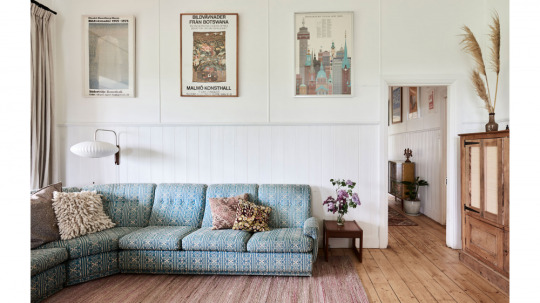
The home of Shelley + Tom Banders in South Gippsland. Photo – Eve Wilson for The Design Files. Styling – Annie Portelli.

The home of Shelley + Tom Banders in South Gippsland. Photo – Eve Wilson for The Design Files. Styling – Annie Portelli.
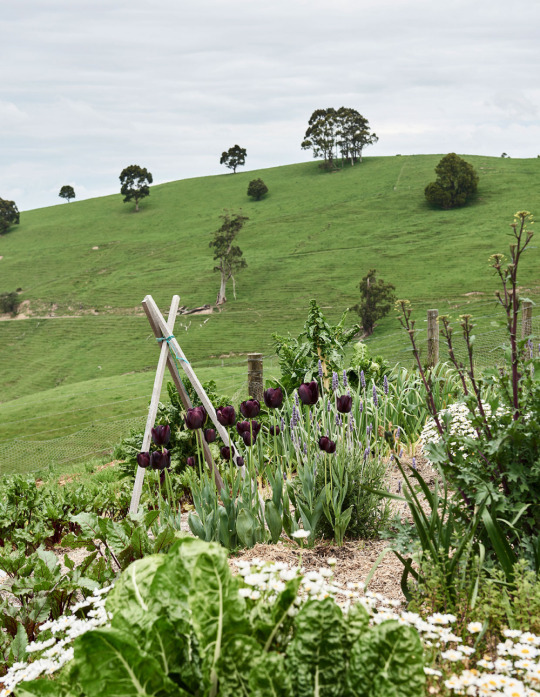
The home of Shelley + Tom Banders in South Gippsland. Photo – Eve Wilson for The Design Files. Styling – Annie Portelli.
Living The Regional Dream In Strzelecki, South Gippsland!
The proverb ‘the grass is always greener on the other side’ is totally redundant in the case of Tom and Shelley Banders, whose idyllic country home is nestled in South Gippsland’s famed rolling hills where – literally and figuratively – the grass could not be any greener! The pair moved from Melbourne into their charming 1890s farmhouse with 10ft walls and have never looked back, establishing 70 lineal metres of veggie patches, a stone fruit orchard and citrus grove, with plans to establish coops for chickens and ducks. Shelley makes a strong case for taking the leap to the country:
‘Just go for it! We have never felt so grounded, connected and satisfied, ending our day with a glass of local wine, a bit of dirt under our nails and a belly full of real food. What are you waiting for?’
I honestly don’t know!
Revisit the original story here.
1 note
·
View note